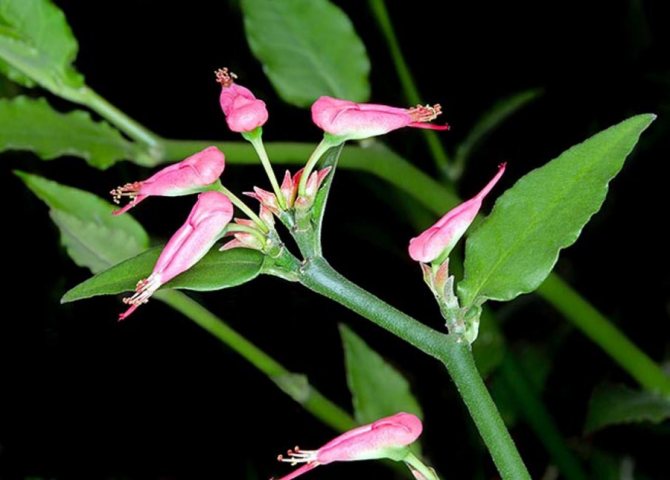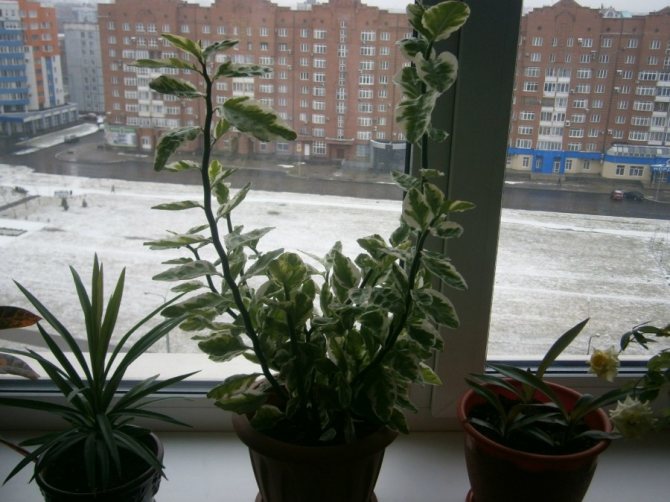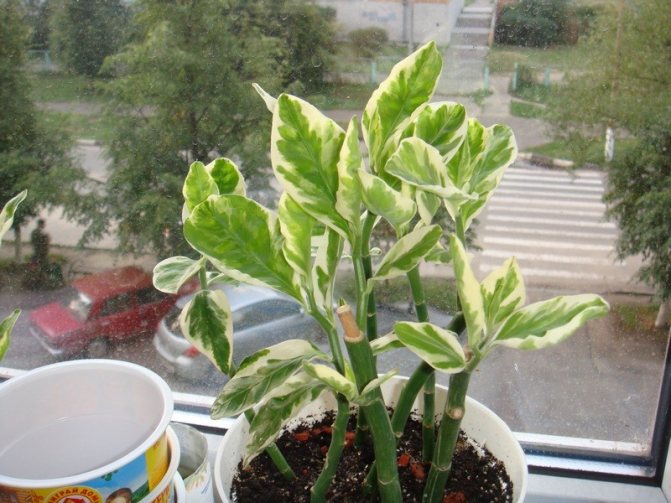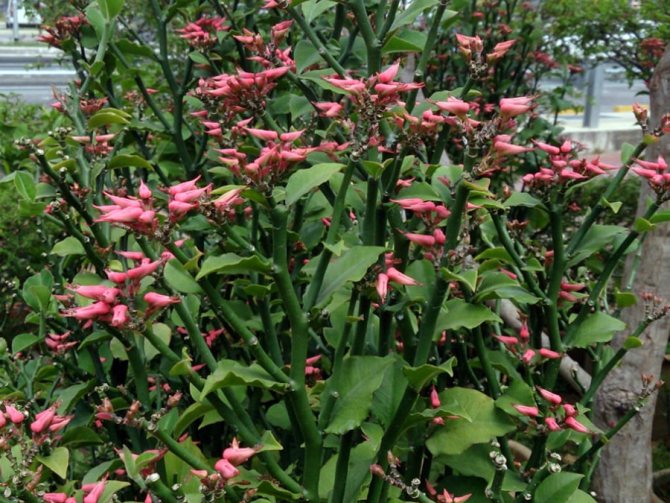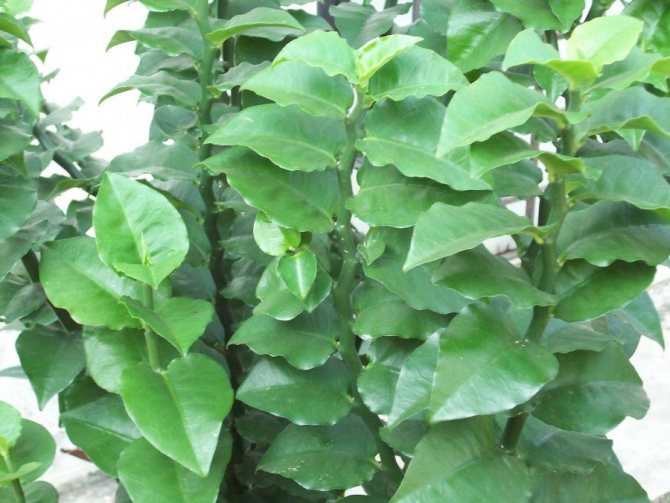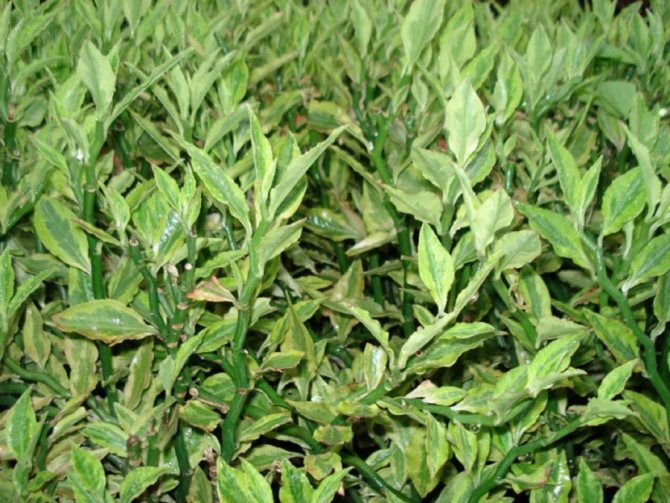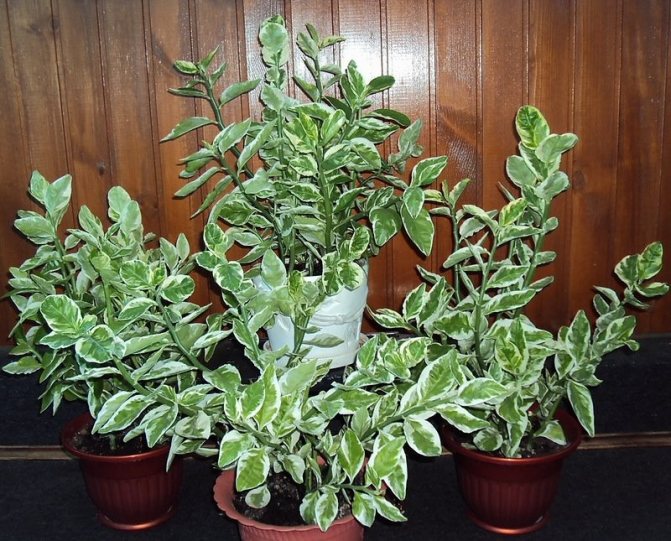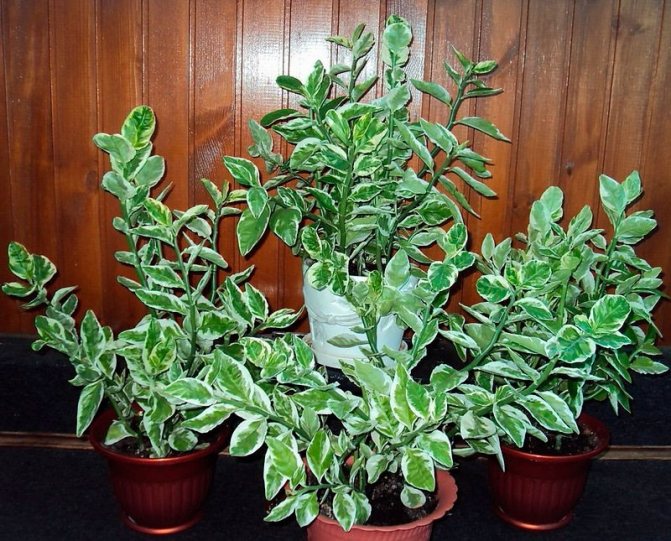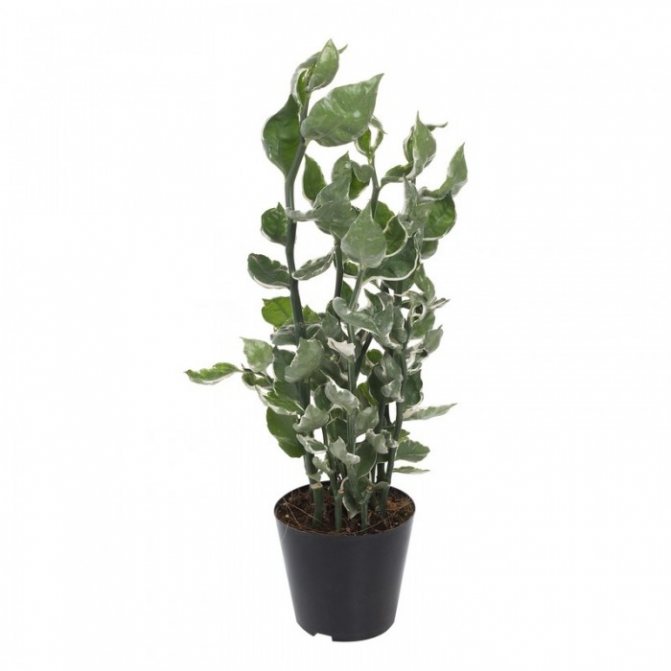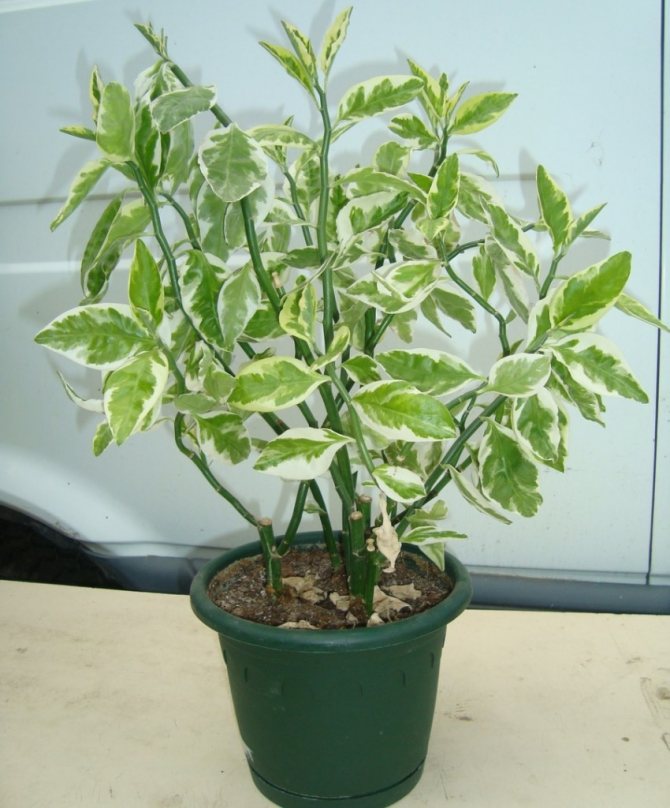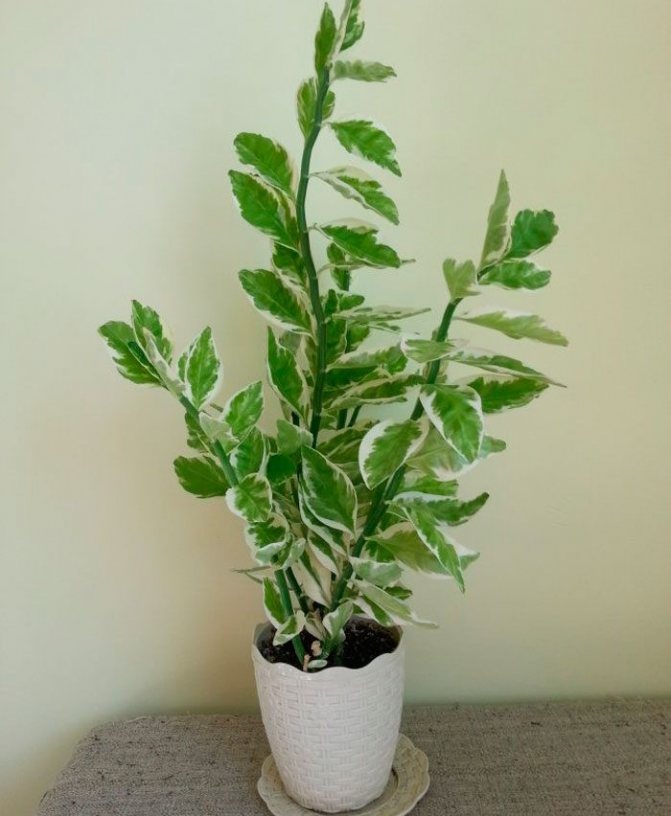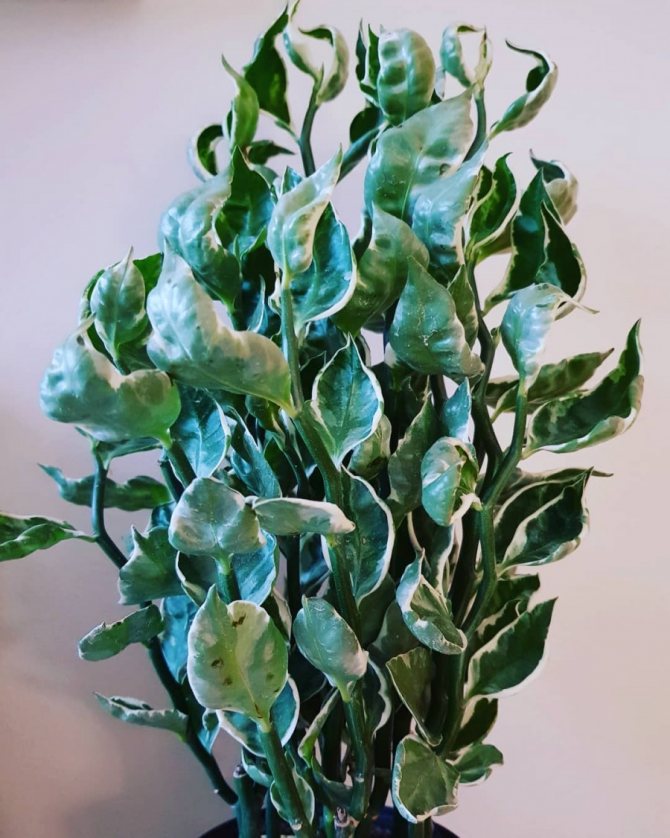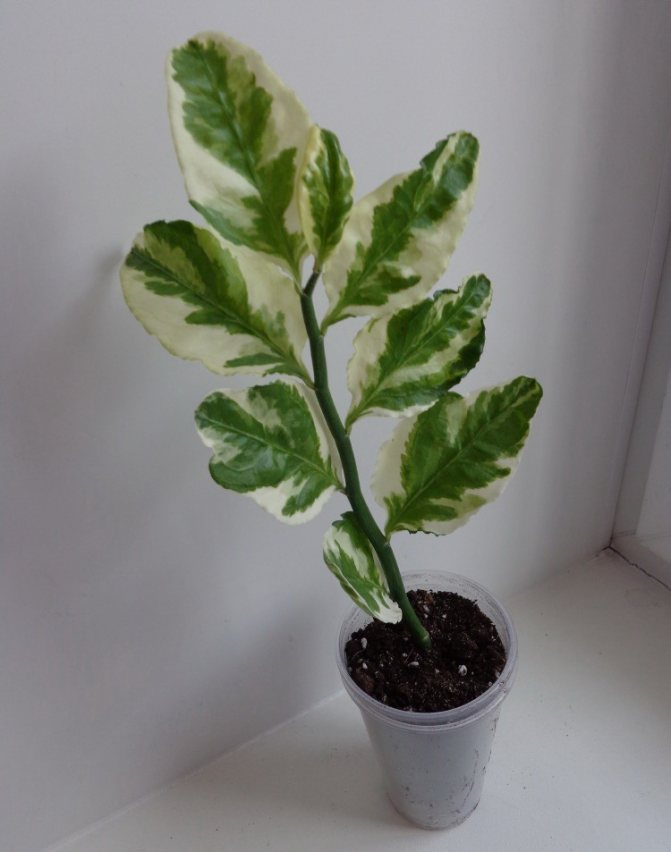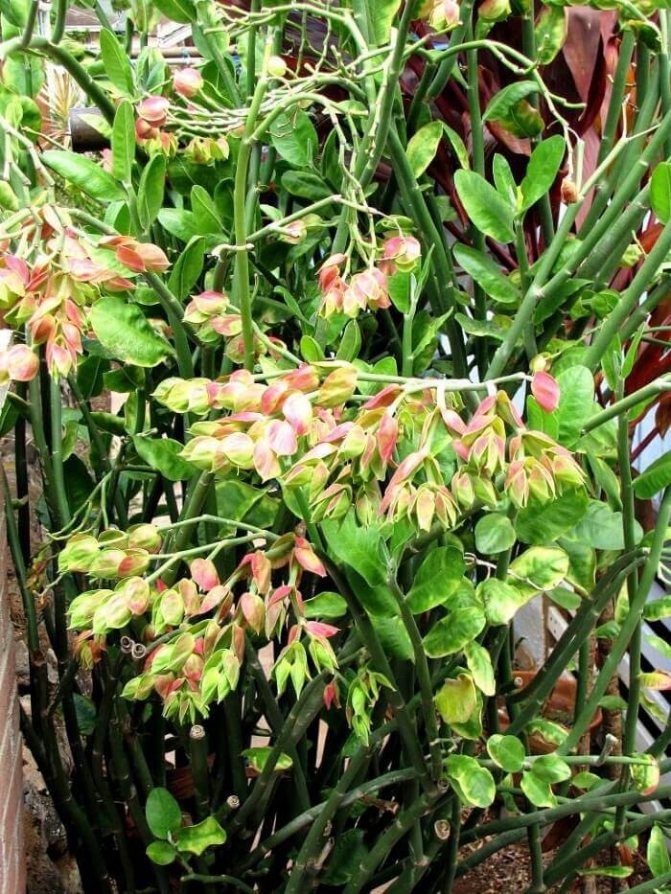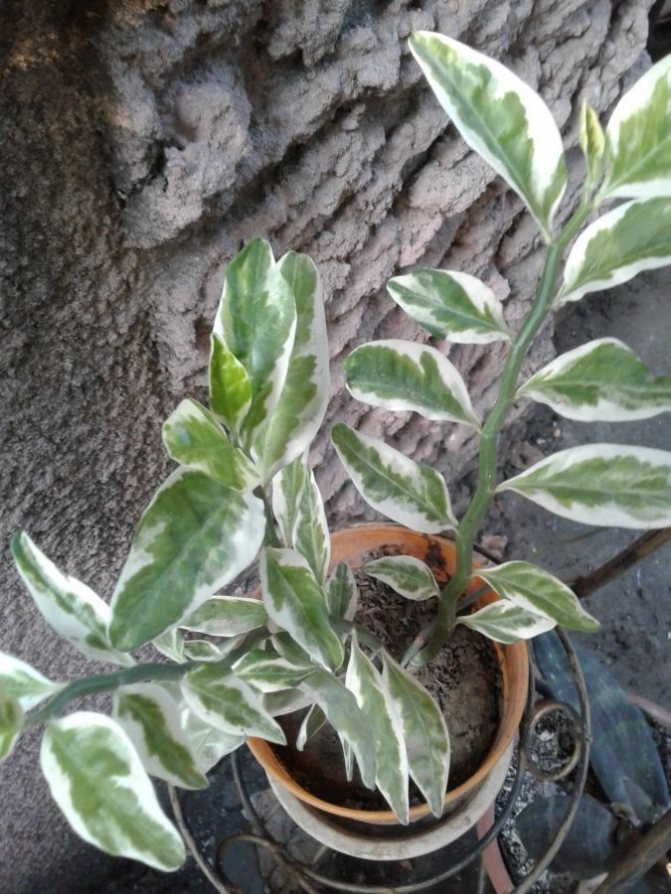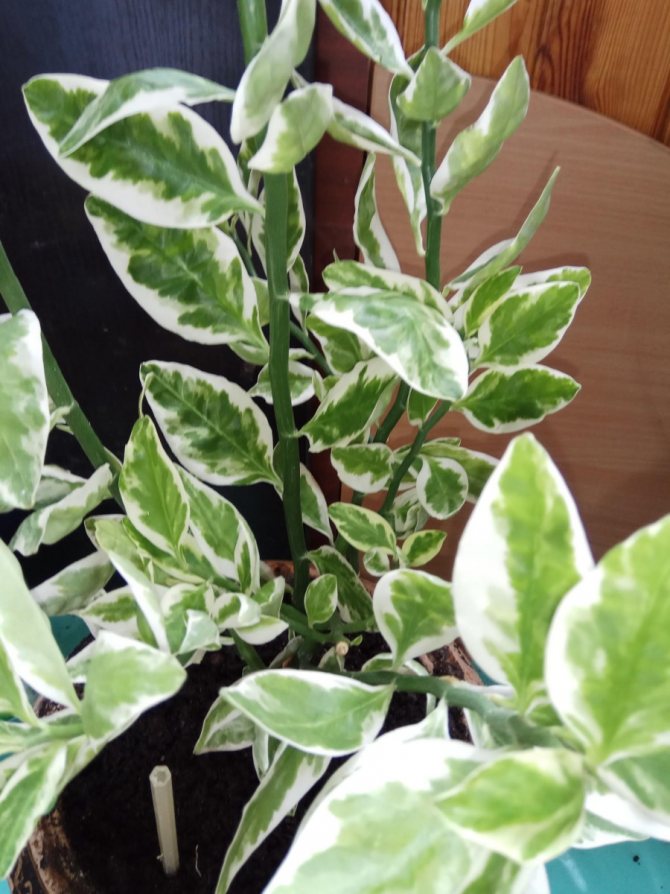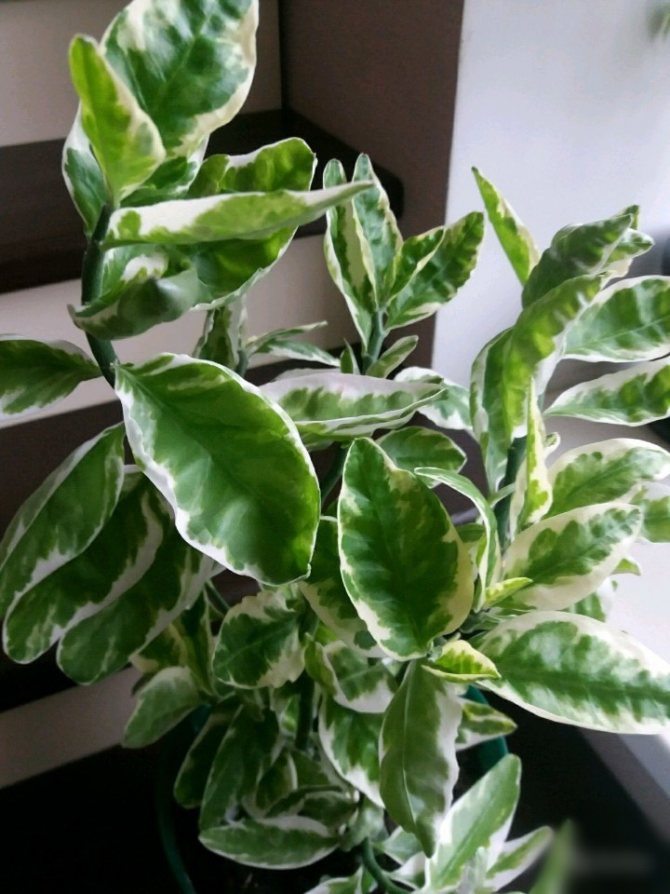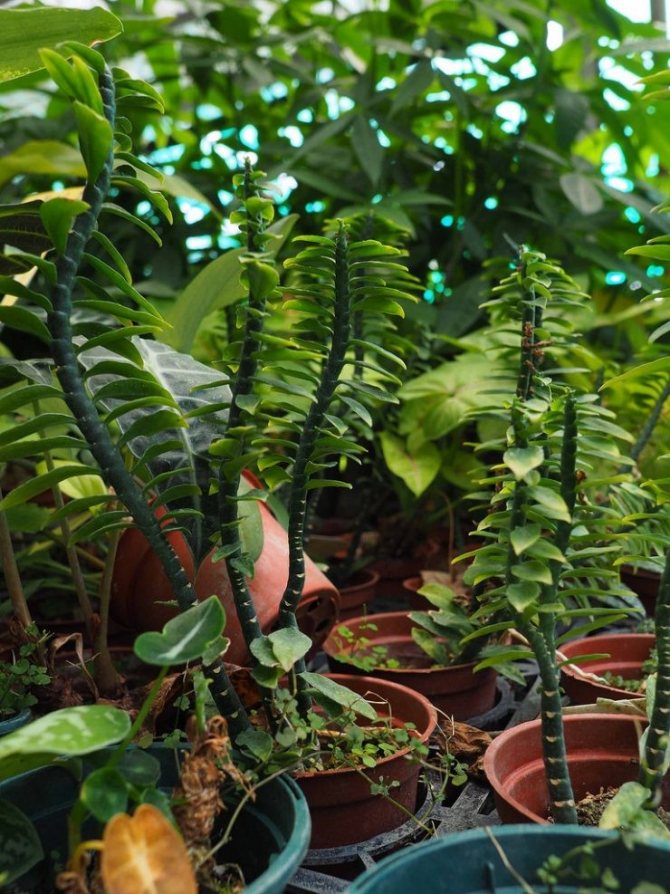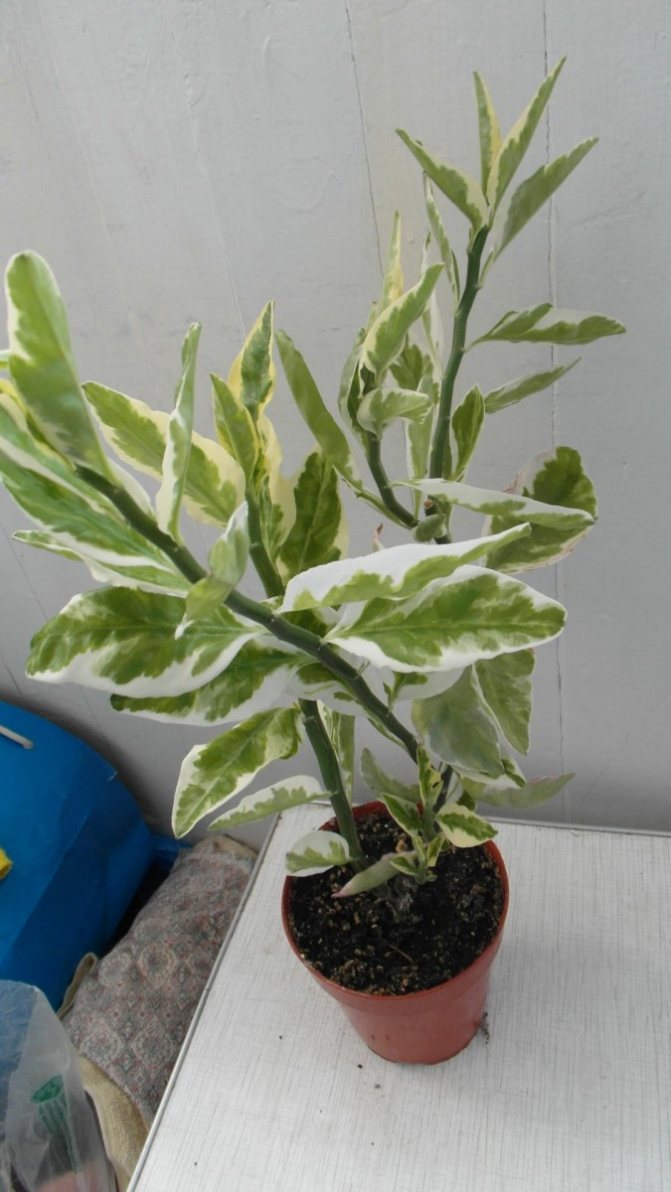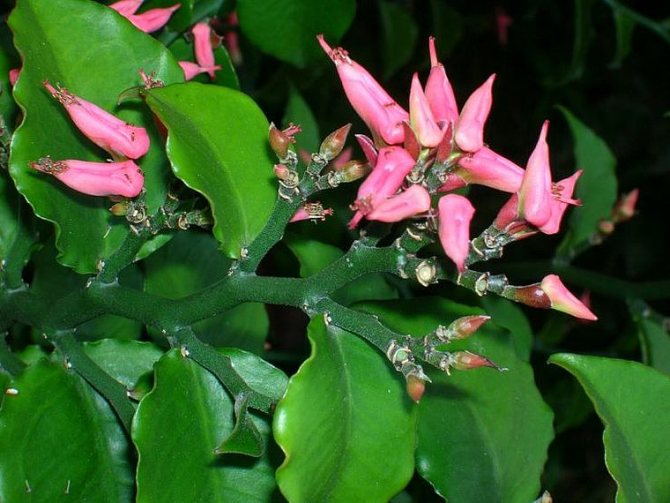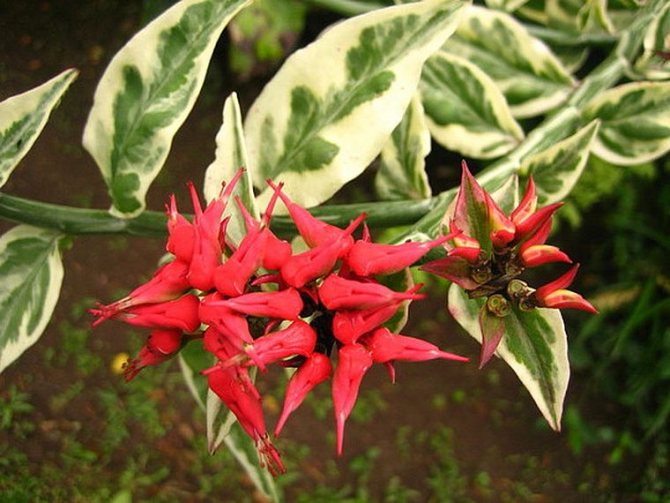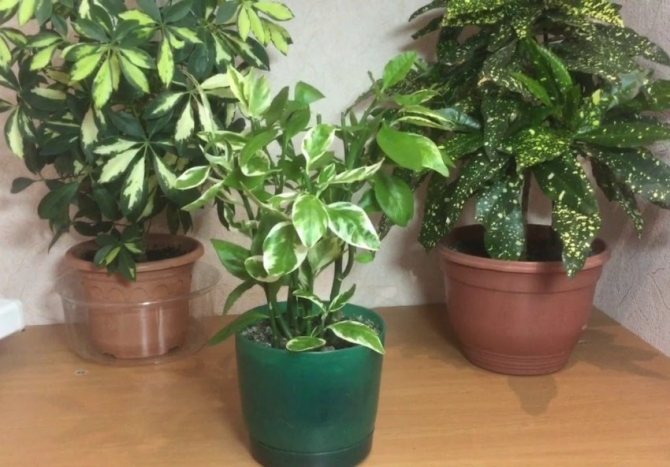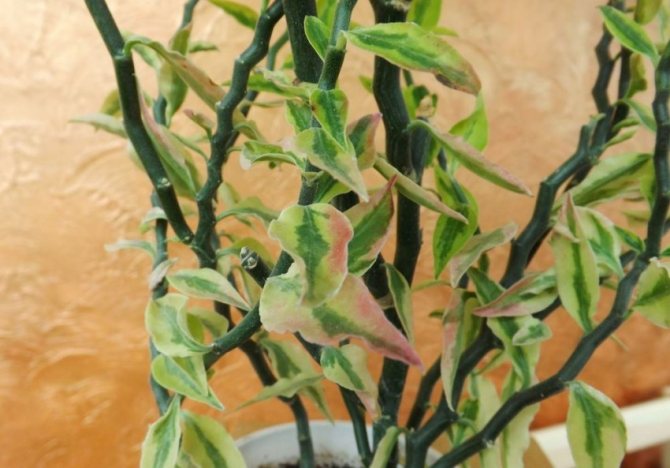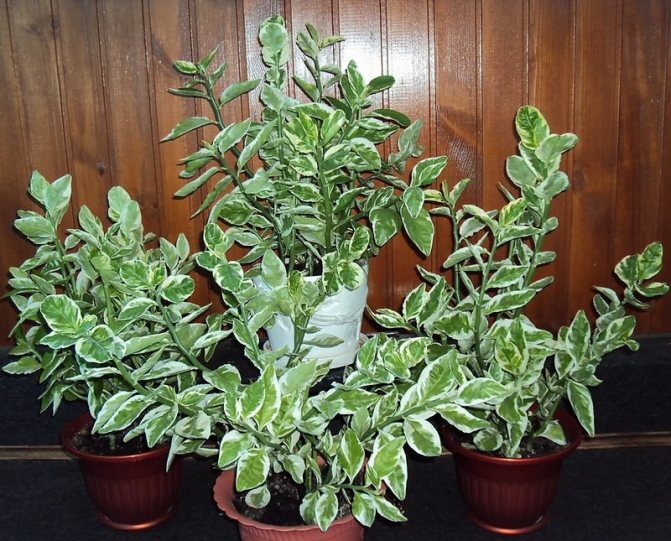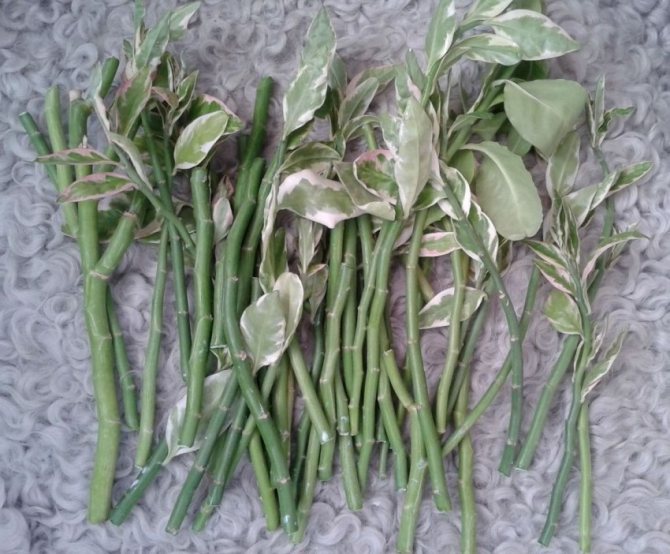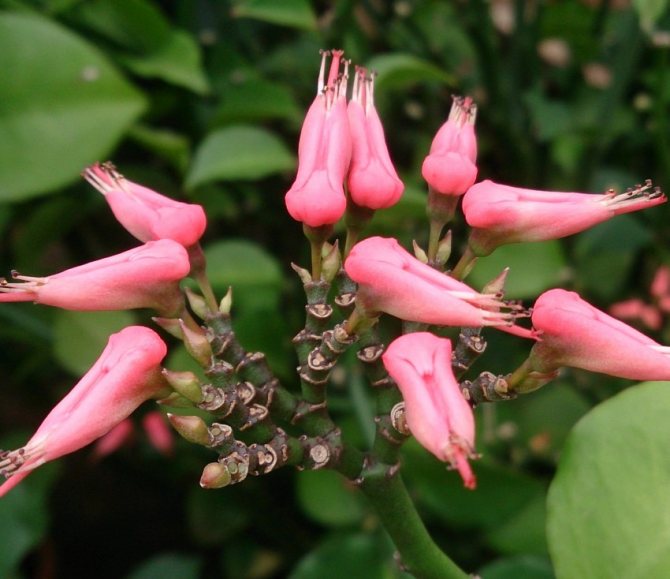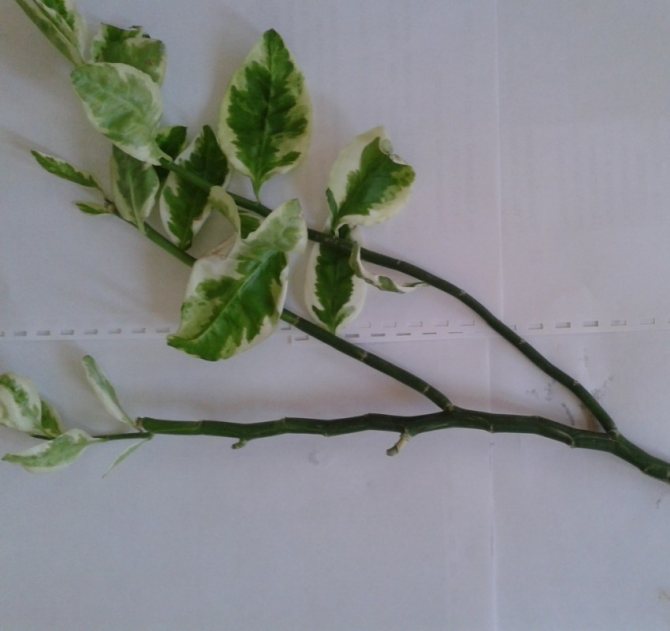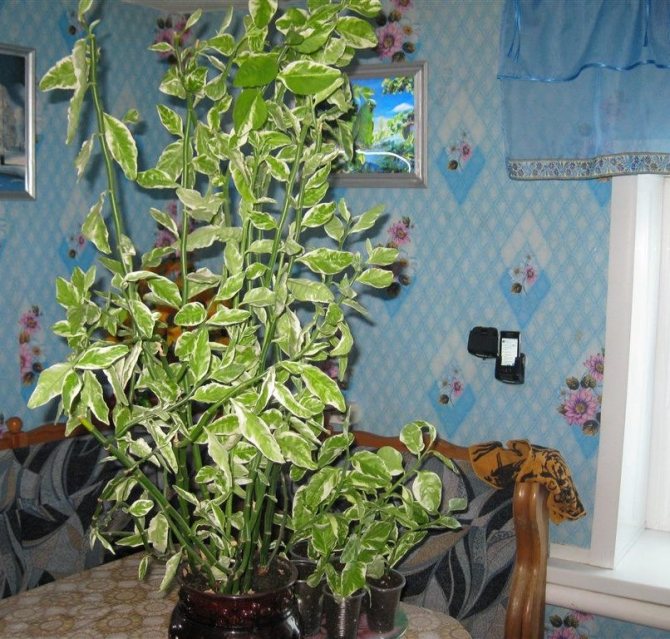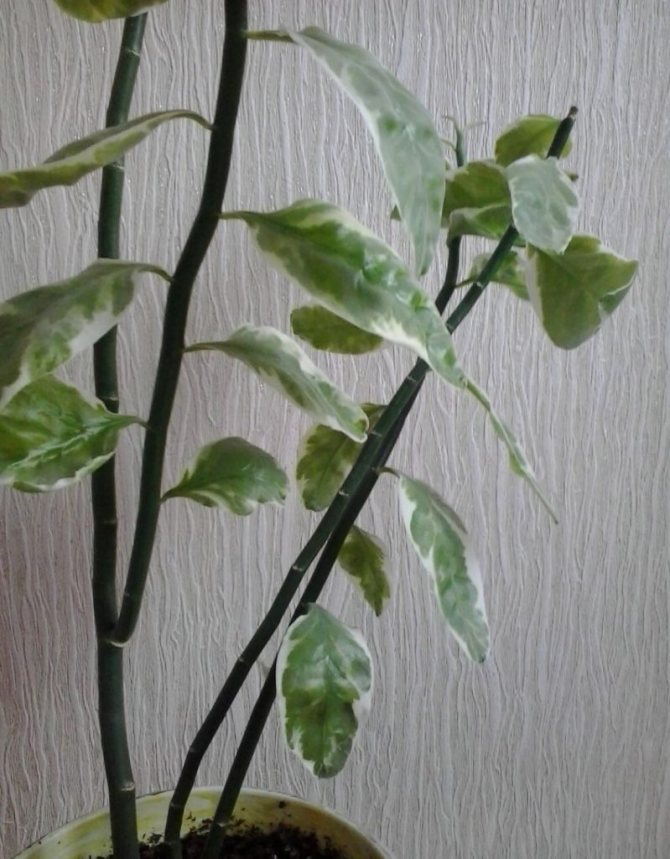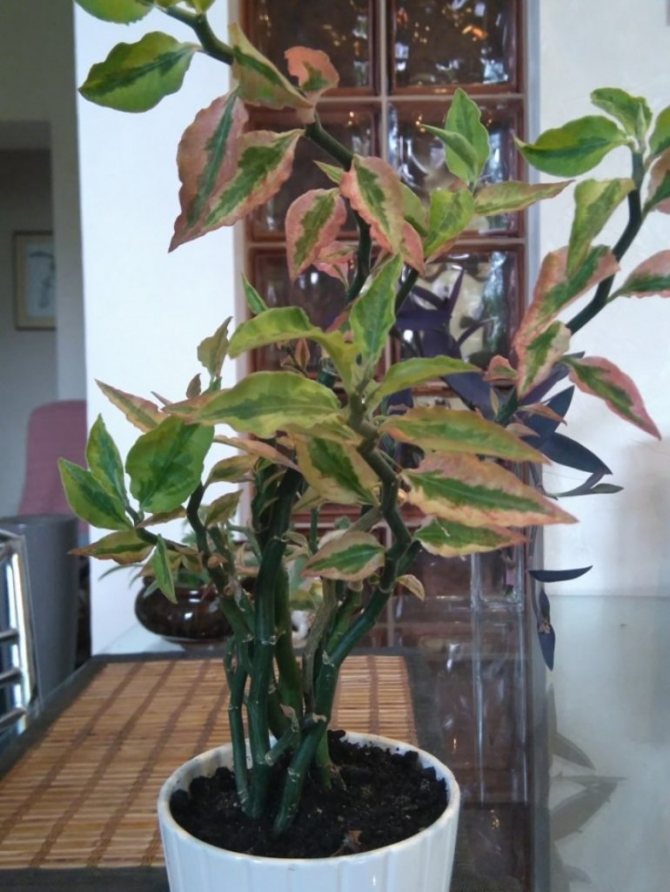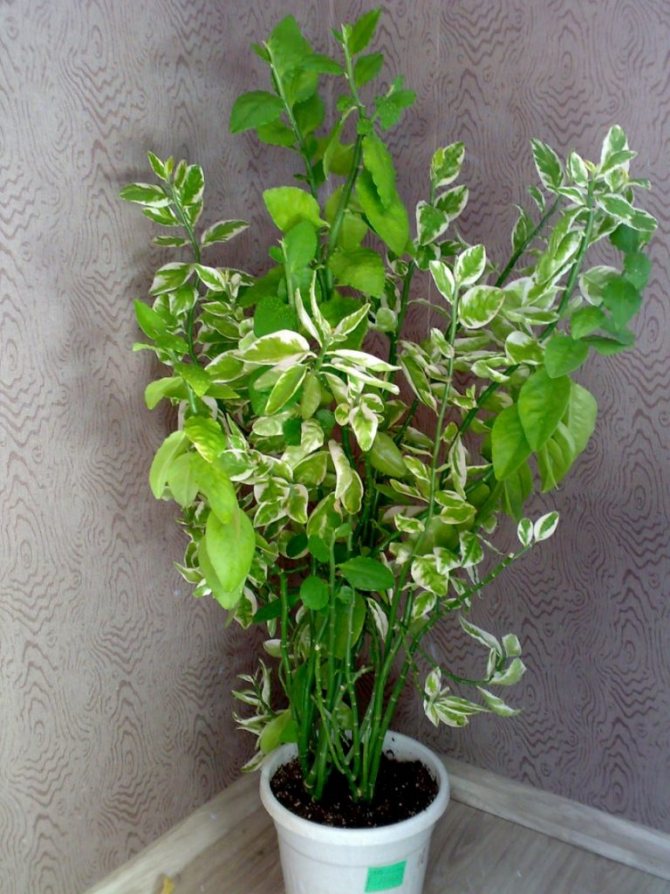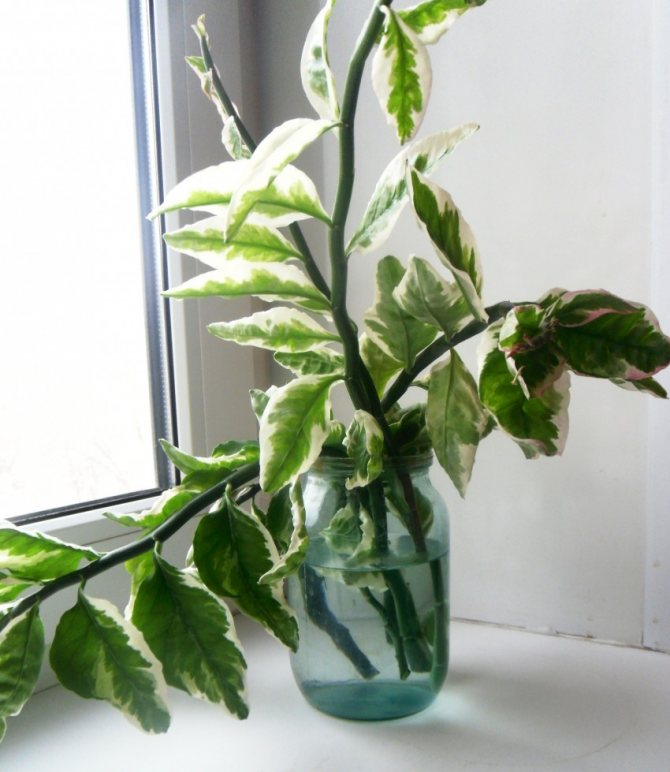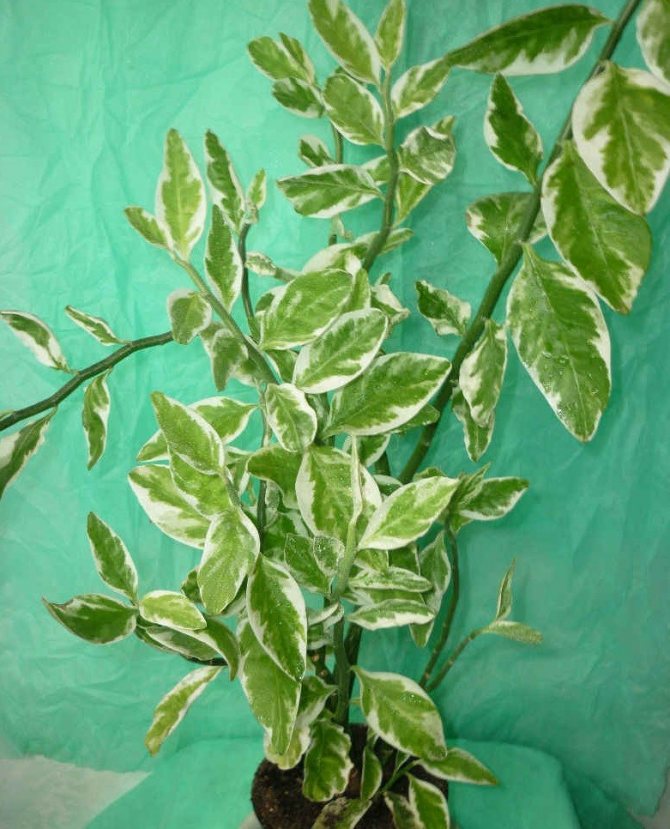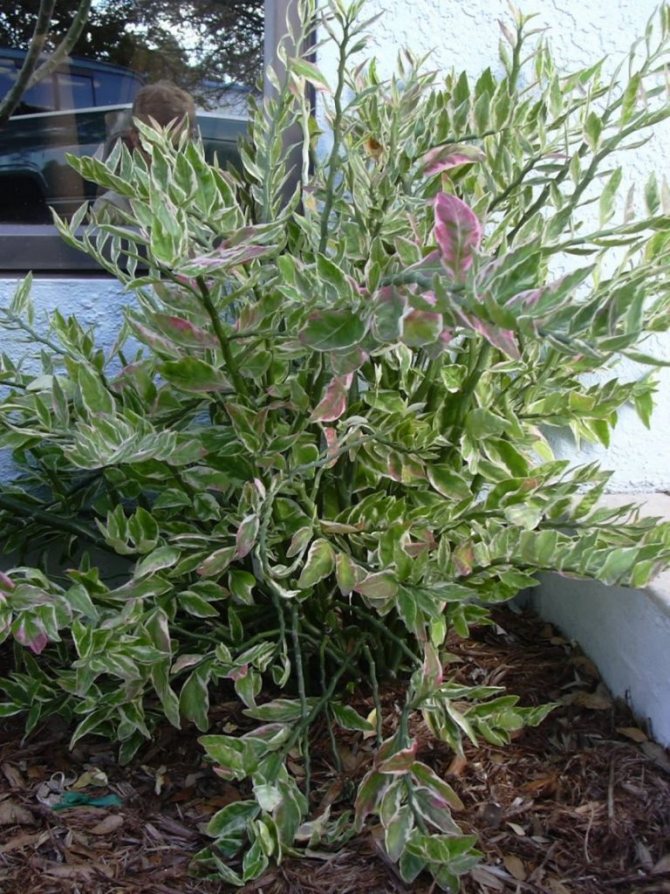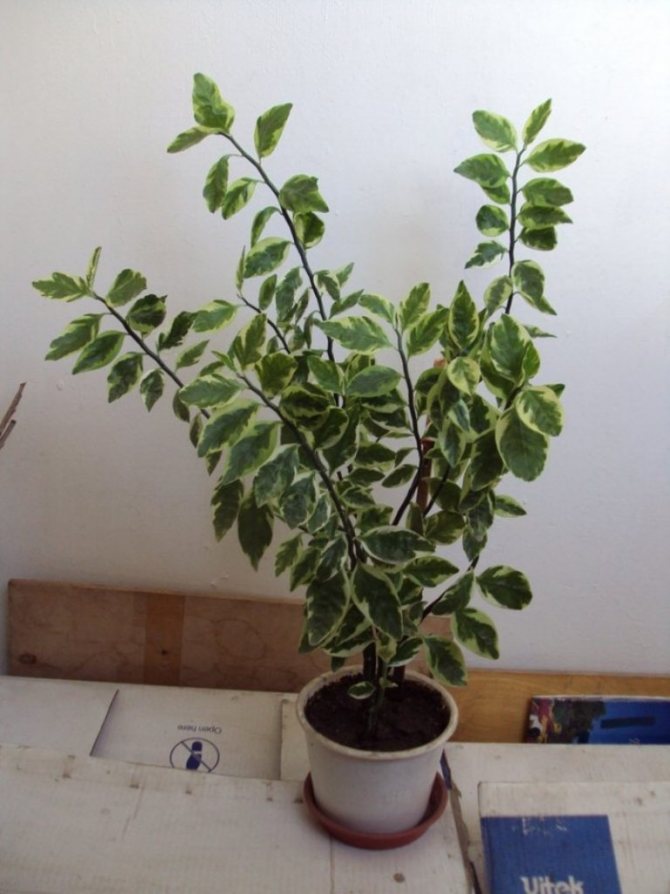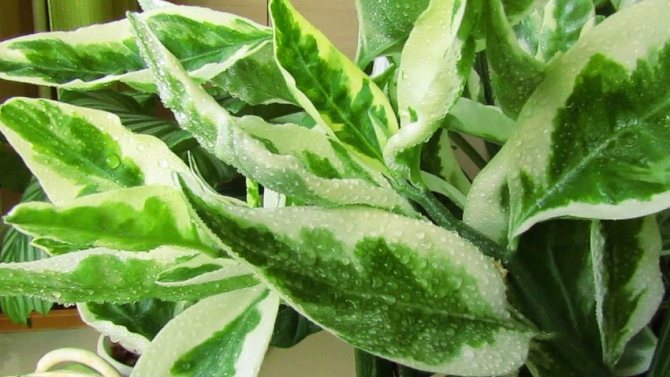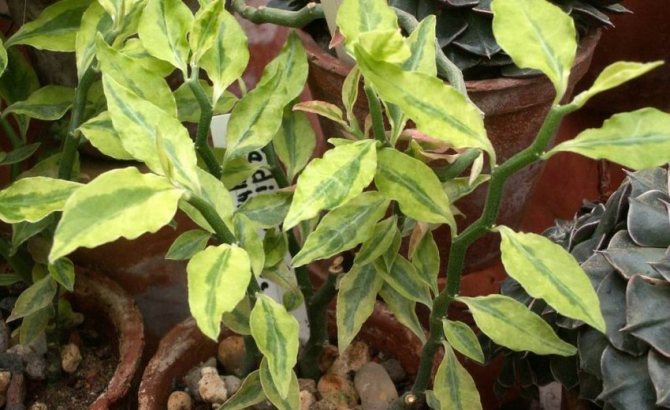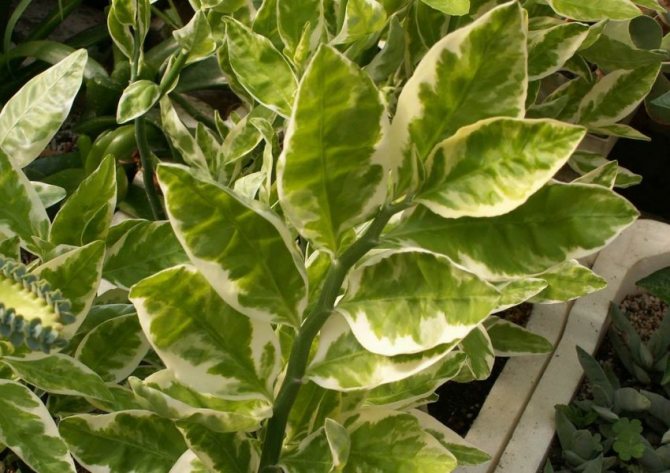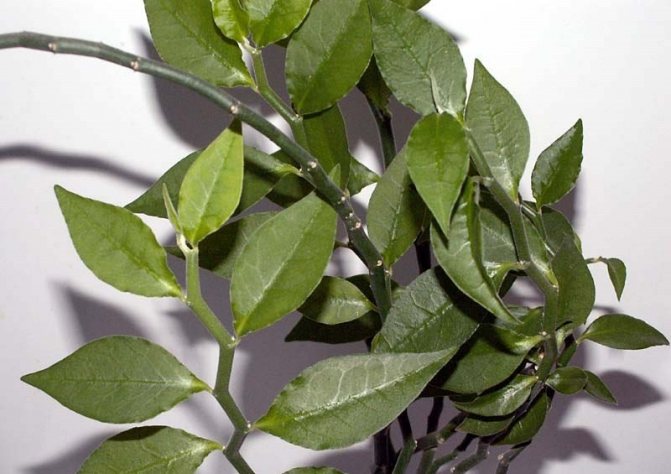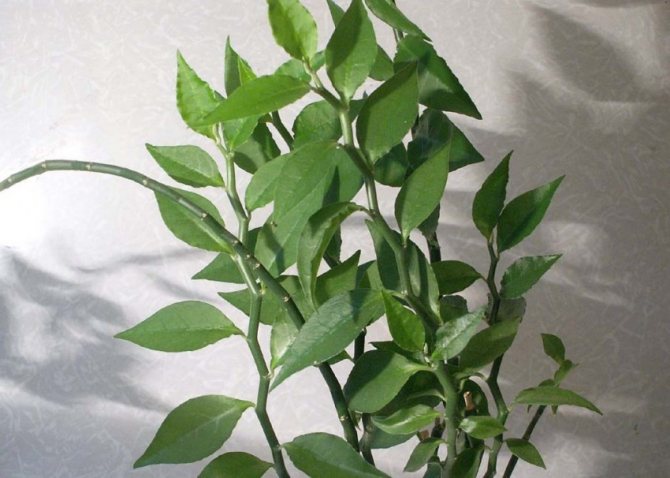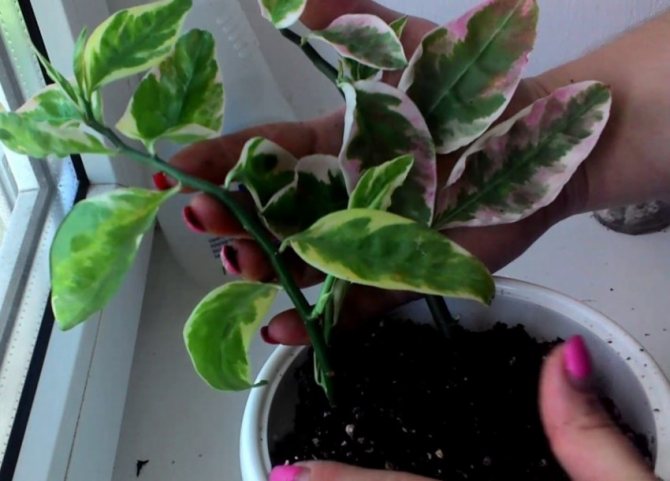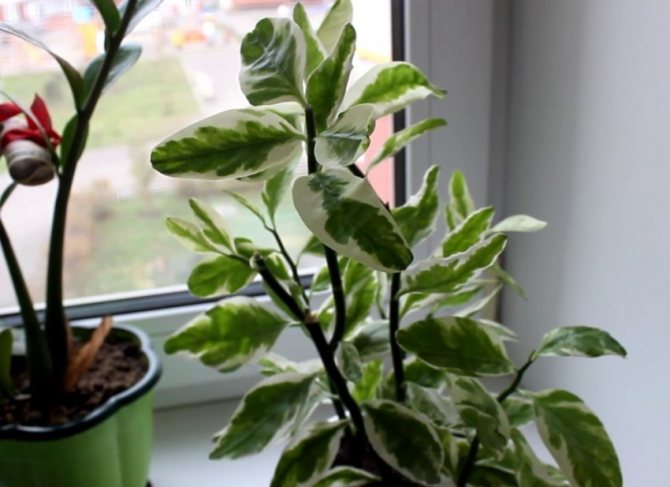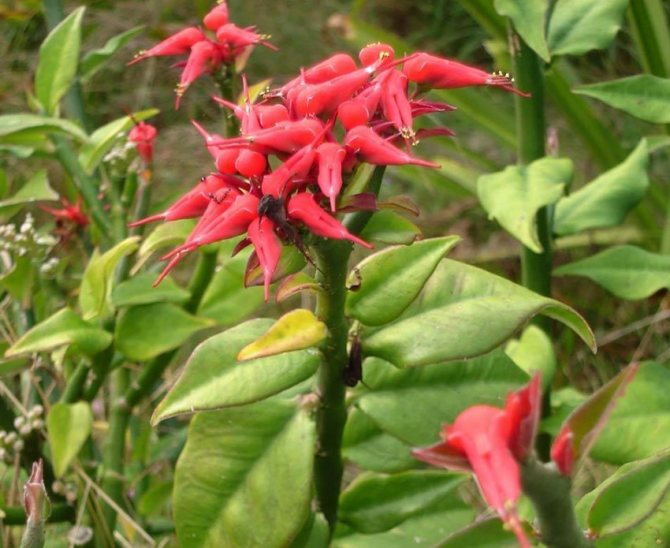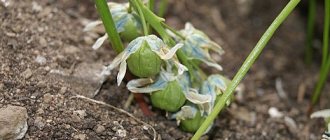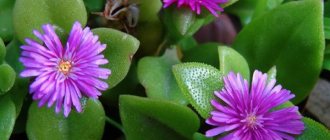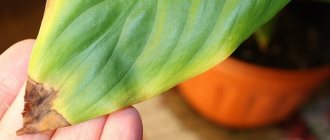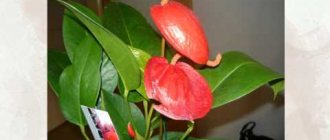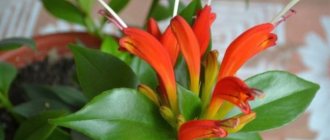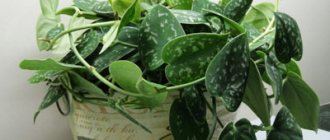A plant like pedilanthus (Pedilanthus) belongs to a rather large family of Euphorbiaceae. It is a highly branching shrub. In nature, such a plant can be found in Central, North, and South America.
Different species can grow in places that differ significantly from each other in natural and climatic conditions. In this regard, such plants outwardly differ quite strongly from each other. So, for example, titimaloid pedilanthus is a compact shrub with fairly dense foliage, and it prefers to grow in dry tropical forests. In the same forests, pedilanthus spur also grows, but it may outwardly look like a small tree. And such a succulent as large-fruited pedilanthus has almost no foliage, but it has water-storing tissues. In humid rainforests, you can find the finca pedilanthus.
This genus was named pedilanthus because of the appearance of the flowers. So, in translation from Greek "pedilon" means "shoe", and "anthos" - "flower". A characteristic feature of this kind of succulents are spectacular flowers. Because of them, that plant is so popular with flower growers.
What is a plant
Is it possible to keep titimaloid pedilanthus in the house
Considering that it is a succulent plant, growing a plant is not particularly difficult. Which adds one more plus sign in his favor. At the same time, do not forget that all euphorbiases secrete a milky poisonous juice. On contact with the skin, it causes at least a burning sensation, and in the presence of a wound, inflammation.
In no case should even a piece of a leaf be allowed to enter the stomach - this is 100% poisoning.

But not everything is so sad and the variegated bush has its own advantages, except for appearance, because it is capable of:
- disinfect and purify the air;
- fill the room with oxygen;
- absorb toxins;
- act as an antiseptic (essential oils destroy disease-causing bacteria).
Not without popular superstitions. Many believe that a pedilanthus, taken as a gift, promises a good change. Some knowledgeable people assure that unmarried girls should stay away from him at all. The variegated bush does not tolerate male rivalry and will escort potential suitors.
Believe it or not, it's up to you. One thing is for sure: it is impossible to keep a titimaloid pedilanthus in a children's bedroom. Also, the plant should be placed higher if there are animals in the house so that they do not accidentally gnaw the leaves and get poisoned. Thus, taking care of the safety of all family members, it would be quite nice to get yourself such a spectacular handsome man.
Is it possible to keep a pedilanthus at home and where to put it in feng shui
Remembering the toxicity of pedilanthus, it is better to keep it in the living room or bedroom, away from children. This is perhaps the only drawback of the plant. Due to its spectacular appearance, pedilanthus will perfectly fit into any interior and will take pride of place among exotic plants. And for the healing cleansing properties of pedilanthus, connoisseurs of a healthy lifestyle love.
The pot with the plant should be placed where there is a lot of light, but protected from direct sunlight, but northern windows will not work here.
Feng Shui experts advise placing the pedilanthus in the Health Zone (east side) or in the Family Zone (west side). Here, the plant will be comfortable in terms of illumination and the benefits for households will be optimal.
By the way, in the warm season, pedilanthus can be planted in flower beds and in gardens. Just be sure to save from the scorching sun.
Pedilanthus at home - video
Seeing Pedilanthus for the first time, many people mistake it for an artificial flower. This succulent shrub from the euphorbia family (Euphorbiaceae) can grow up to 60-80 cm in height, but large plants lose their decorative effect, since the lower part of the shoots becomes bare over the years. Pedilanthus is a perennial, its shoots grow 15-20 cm in height in a year.
Florists grow it as a house plant, and the homeland of pedilanthus is the subtropical and tropical regions of America. In addition to ornamental leaves, the plant has an interesting flowering - small flowers collected in umbrella-shaped inflorescences have a pair of bright red coverts. Pedilanthus should be kept out of the reach of animals, as it has a poisonous milky juice.
Be sure to read in detail about euphorbia and jatropha.
| Average growth rate. Shoots grow 15-20 cm in height per year. |
| Blooms in winter. |
| Easy to grow plant. Suitable even for a beginner. |
| Perennial. |
How to trim a pedilanthus to shape a bush
How to crop a pedilanthus photo
- For the decorative design of the bush, systematic pruning is carried out, leaving shoots no more than 10 cm.
- The absence of formative pruning will make the plant shapeless, the shoots will stick out in different directions, depriving the flower of its decorative value.
- The first pruning is carried out after the plant reaches 20 cm, then as needed, creating the desired appearance.
- They try to cut the longest branches, then branching often appears at the cut point, and the bush becomes thicker.
Indoors, the pedilanthus reaches a meter in height, wild species can stretch up to 2 m.
Rejuvenating pedilanthus pruning
- The plant eventually loses its decorative effect due to stretched and bare branches, in this case, rejuvenating pruning is performed.
- The flower is cut almost completely, leaving hemp of only 5-6 cm.
- Such an operation acts regeneratively, forcing the plant to go into active growth.
- After pruning, it is good to feed the flower at the root with a complex fertilizer for flowering plants.
Pruning can be combined with replanting and renewing the soil in a pot, so as not to disturb the plant once again.
Pedilanthus: home care. Briefly
When growing pedilanthus at home, you need to follow the rules of care, then it will preserve the decorative effect of the leaves, it will bloom regularly. Basic requirements for the care of pedilanthus:
| Temperature regime | In summer, no hotter than 25-30˚С, in winter, exclude drafts. |
| Air humidity | High, in winter they additionally spray the plant, add water to the pan. |
| Lighting | Bright light, preferably on a west side window. |
| Watering | In summer, the soil should be moist, in winter it is watered every 5 days. |
| Priming | Fertile, with sand and peat content. Drainage is required. |
| Top dressing and fertilization | Organic is preferred. Top dressing after 3 weeks with liquid mineral fertilizer. |
| Pedilanthus transplant | In the spring, if the roots have completely filled the pot. |
| Reproduction | Apical cuttings, seeds. |
| Features of pedilanthus | Does not tolerate drafts, gas combustion products. |
Reproduction
By purchasing one plant, you can use it to create an entire flower gallery at home. Pedilanthus reproduces in two ways:
- Seeds - read an article on how to grow succulents from seeds
- Cuttings are the processes at the very top of the stem.
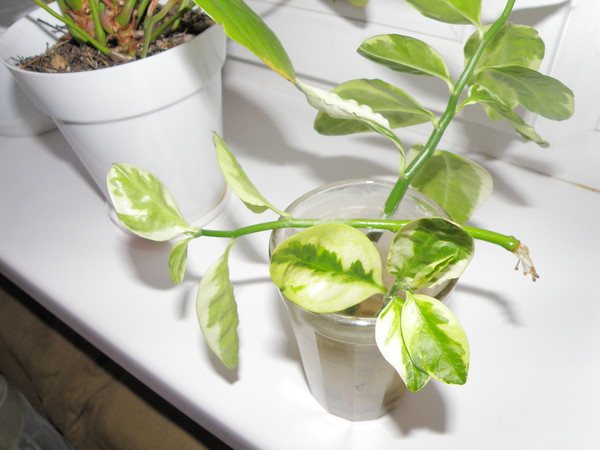

The second breeding method is best used in spring or June. To obtain a cutting, the upper part of the shoot is cut to a nodule up to 10 centimeters long. The cut place plentifully secretes juice. We stop juicing by placing the pruning in warm water. Then the cutting is dried and after one or two days it can be planted in a prepared pot filled with sand or perlite. The room should not be cold, otherwise the plant will not take root. The optimum temperature is 20 degrees.
Only a few upper leaves can be left on the handle, all the rest must be removed. The first roots appear 14-20 days after planting.
When working with cuttings, certain safety measures must be observed, since pedilanthus juice is poisonous. Therefore, gloves should be worn before circumcision.
Home care for pedilanthus. In detail
To preserve the decorative foliage and activate the flowering of the plant, pedilanthus care at home should be appropriate. It includes a set of activities.
Flowering pedilanthus
Unusual inflorescences on pedilanthus rarely appear; it is grown mainly for the sake of decorative foliage. You can admire the flowering only if it was properly cared for - in winter it passed a dormant period, optimal lighting and temperature conditions were created.
Inflorescences appear in November-December, and as they wilt, they are cut off with scissors. After cutting the last flower, the plant is sent for wintering.
Temperature regime
Like all tropical plants, the home pedilanthus is heat demanding. In the spring and summer, the shrub is kept at a temperature of 22-26˚С. In winter, the plant should be at rest, and the temperature should be reduced to 15-17 ° C, which is necessary for laying flower buds.
However, the pot of pedilanthus should be kept away from heating appliances, otherwise the plant will shed its leaves.
So that the shrub does not suffer during airing, it must first be covered or taken to another room.
Spraying
When growing a pedilanthus plant at home, you do not have to create special conditions for humidity. This shrub tolerates dry air of an apartment well.
Spraying the crown is necessary only for leafy varieties of pedilanthus, mainly in winter, when the air is dry. The shrub is not sprayed after cuttings and pruning, which will avoid decay of the shoots.
Lighting
For a pot with a pedilanthus, it is necessary to choose a well-lit place, a window sill on the southeast, south or southwest side of the house is preferable. To protect the plant from the burning direct sunlight, the flower is placed on a table near the window. In summer, it is recommended to take the pedilanthus out into the open air, protecting it from sunlight and precipitation.
Watering pedilanthus
Being a tropical plant, pedilanthus at home is picky about watering. It reacts negatively to overflow and lack of moisture in the soil. With an excess of moisture, the plant's roots rot, it sheds its leaves and stops blooming. In spring and summer, pedilanthus is watered regularly, in moderation, keeping an eye on soil moisture.
From December to March, when the air temperature is low, watering is reduced. For watering pedilanthus, use only filtered water at room temperature or settled in a bottle for 2-3 days.
Pedilanthus pot
Pedilanthus can be grown in a pot made of ceramic, plastic. When choosing a container of a suitable size, one should be guided by the size of the root system of the shrub. If you transplant the plant into a large pot, the soil will turn sour. For young seedlings, cactus pots with drainage holes are suitable for draining excess water.
Priming
For good development, pedilanthus should be planted in light, loose soil.From store-bought soils, you should choose soil for succulents, to which sand is added. You can independently compose such a soil from equal parts of leaf and sod land and coarse river sand.
Be sure to add vermiculite or wet coconut substrate to exclude soil acidification processes.
Top dressing and fertilization
It is necessary to feed the pedilanthus for its normal growth and flowering. Liquid fertilizers are applied from spring to the end of summer, always after watering with water. It is enough to feed the shrub with fertilizer once a month, which contains iron, phosphorus, calcium, while there should be a minimum of nitrogen. Excess nitrogen will lead to rotting of the root system.
Transfer
Annual transplantation of pedilanthus is not carried out due to the slow development of the root system. Signs that the pedilanthus needs to be transplanted:
- The purchased shrub must be transplanted by changing the soil and pot.
- Roots emerged from the drainage holes in the pot.
- The roots and base of the stem rot.
Popular types
This exquisite houseplant belongs to the Euphorbia family. Florists are especially delighted with the unusual shape of the flower; it is to her that the plant owes its original name. The name is formed by two Greek words pedilon (translated as slipper and shoes) and anthos (translated as flower). The flowers of the plant really resemble the shape of an elegant shoe, suitable for a little elf's leg.
The color of the "shoe" varies from pronounced red to pale pink. Flowers are no more than two centimeters in length. They are collected in elegant umbrellas, which makes the plant incredibly beautiful during the flowering period. Young bushes have stems covered with dark green bark. The older the shrub, the more its shoots resemble the trunk of an ornamental tree.
The leaves of the pedilanthus are shiny, as if covered with wax, often oval in shape with a sharp end. Depending on the type of plant, they range in color from bright green, pink, or multi-colored when the leaf has a white border. In the wild, about 15 species of shrub are read, which reaches a height of 2 meters with a stem thickness of 2 centimeters.
At home, the growth of a flower does not exceed one meter. Locals nicknamed the plant "the devil's backbone" because of the zigzag formation of the stems.
Pedilanthus tithymaloides
The species is the classic representative of this ornamental shrub. The plant is not whimsical, it can be placed on the windowsill in any, even the northern part of the apartment, subject to normal lighting. During growth, a spreading bush is formed, enveloped in ovoid petiole leaves. They are very large. In adult plants, for a leaf it can reach 10 centimeters, and a width of -5 centimeters. During the flowering period, the top of the plant is covered with small inflorescences, consisting of seven red or orange flowers.
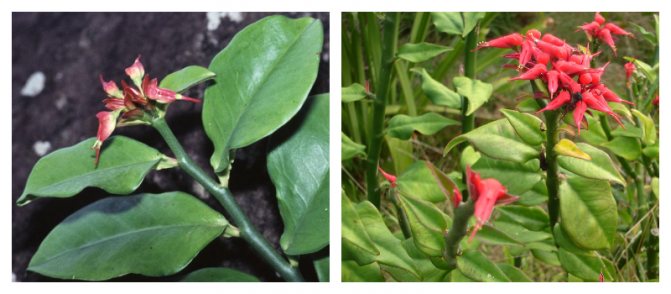

Pedilanthus titimaloid
Pedilanthus variegated
Variegant pedilanthus got this name because of the variegated leaves, with a beautiful white edging. At the very top of the shrub, attractive flowers appear, shaped like shoes and a tropical bird at the same time. The color of the crown leaves largely depends on the lighting, so they can be from bright green to whitish.
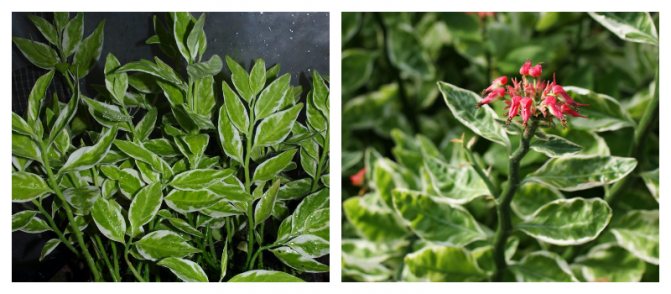

Pedilanthus variegant
Large pedilanthus (Pedilanthus macrocarpus)
A distinctive feature of this species is large, fleshy stems that can accumulate moisture. The shrub easily tolerates drought and heat. There are practically no leaves, they look like round scales in which nutrient fluid accumulates. During the flowering period, bright red inflorescences appear at the very top of the plant.


Large pedilanthus
Pedilanthus finkii
The shrub loves tropical rainforests.The shoots of the plant form intricate zigzag curves that make the plant inimitable. P. Fink can be called a low tree, since its growth can exceed 1.5 meters. The plant is crowned with a beautiful, green crown of bright leaves. Below the trunk is bare.
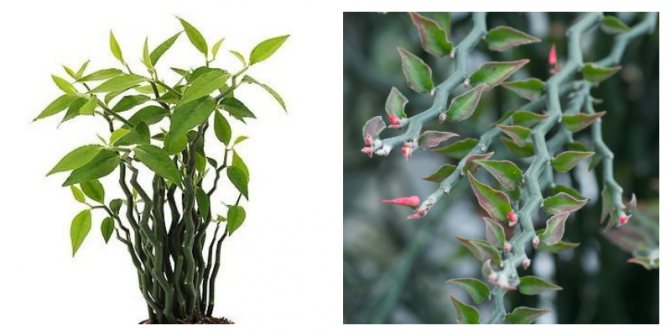

Pedilanthus Finca
Pedilanthus coalcomanensis
A graceful representative of its kind. It boasts large scarlet or bright pink flowers, collected in inflorescences up to 4 centimeters in diameter. A shrub native to Mexico, where the dry and rainy season is clearly expressed. Therefore, the succulent sheds its leaves in winter.


Pedilanthus koalkomanensky
Pedilanthus titimaloides diff. low (Pedilanthus tithymaloides v. nanus)
This is not a tall evergreen shrub up to 3 meters high. Leaves are attached to the trunk with petioles, parallel to each other. They adorn the tree along its entire length. The trunk is straight and fleshy. The leaves are large, with a slight wave at the edges and a length of 6 centimeters. They love to use this shrub to decorate the landscape.
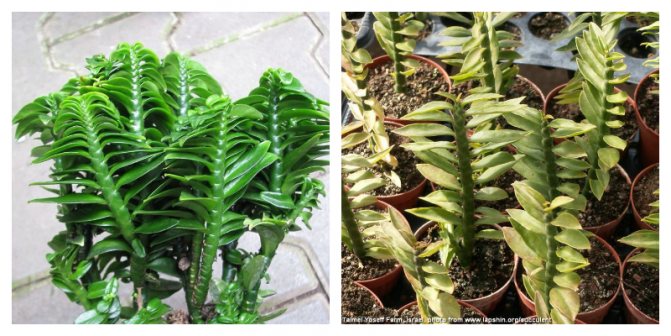

Pedilanthus titimaloides diff. low
Propagation of pedilanthus by cuttings
Cutting pedilanthus is the easiest method for obtaining young shrubs. In the spring, after pruning, the tops of the shoots remain, suitable for rooting (length 10-12 cm).
In the lower part, you need to remove the leaves, after the cuttings are left in a container with clean warm water to stop the formation of milky juice. Wet vermiculite, sand or coconut flakes are poured into the container. The cuttings are buried by 4-5 cm. The plantings should not be covered so that mold and rotting do not appear. The roots will appear in 3 weeks, young plants can be planted in a month.
You can root pedilanthus cuttings in water, to which a tablet of activated carbon and a couple of drops of a root formation stimulator are added.
Pedilanthus transplant and bush formation
Moving to a new place with an increase in the volume of the flower pot is carried out after filling the earthen coma with a network of roots. The vessel changes with an increase of 2-3 cm, the height should be equal to the diameter. Usually, the transplant is carried out in the spring, when the plant is reborn, full of energy, which will minimize the effects of stress. The bottom of the vessel is filled with expanded clay or pebbles, providing drainage of the soil, thanks to which water will not accumulate and stagnate.
Important! Only the transplanted plant needs to be shaded so that the sun's rays do not activate undesirable consequences.
Diseases and pests
When growing pedilanthus, the following problems often arise:
- Pedilanthus leaf tips turn yellow and dry - the reason is too dry air or hot sunlight.
- Pedilanthus leaves become small and fall off quickly - lack of light.
- Pedilanthus leaves fall in winter - the reason for this is the draft and freezing of the shoots.
Pedilanthus does not bloom - there are several reasons:
- Lack of lighting;
- The temperature regime is not observed;
- The period of winter dormancy is not long enough.
- Pedilanthus leaves fall - during the period of active growth of the shrub, the reason is in violation of the irrigation regime and temperature, due to a draft. In winter, you should reduce the frequency of watering and lower the temperature in the room, while maintaining maximum lighting.
- The shoots are stretched - lack of light for the plant. The shoots should be shortened, and the pot should be rearranged to a more illuminated place. In winter, the shoots can become thin due to the warm air.
- Pblackened stem and leaf stalks - due to a dense substrate, excessive watering, which leads to root rot.
Pests of pedilanthus are aphids, spider mites and whiteflies.
Possible growing problems
Pedilanthus titimaloid looks great both during flowering and without inflorescences.Its variegated color of leaves is able to fall in love with everyone; its tubular, shiny stems look like bamboo canes. There are situations when the flower does not gain color, leaves fall or dry out, in order to cope with the problem, you need to know its cause. It is important to monitor the condition of the flower, to carry out the agrotechnical procedures described above in a timely manner.
- The lack of flowering is a consequence of a long period of activity, in winter the plant did not rest as expected, there is not enough energy for the new flowering period.
- Leaves do not fall in winter - you should pay attention to the environment of the flower's existence: light, humidity, watering.
- Why does pedilanthus shed its leaves? - this is the result of exposure to low temperatures during ventilation in winter, sudden movement from street to room. If the stems have not been damaged, the leaves will grow back with the onset of the active growing season. Damaged stems are pruned to a healthy level and the remaining shoots will sprout new shoots.
- Whitewashed leaf color, long stem - an indicator of untimely pruning, lack of sufficient light in the room, high air temperatures.
- Elongated leaf petiole - appears at a later age, is the norm.
- Dried tips of leaves are an indicator of dry air in the room, the plant is hot and uncomfortable, it needs additional sources of moisture. Maybe the scorching rays of the sun on the south side touched the pedilanthus so that the plant leaves were burned.
- Changing the color of the leaves - dark means an excess of nitrogen, lightening - diffused light in the room.
It is simple and within the power of a novice florist to preserve the plant, monitor the condition of the flower, pay attention to its appearance, carry out resuscitation measures in time - everything that a pedilanthus needs for good health.
Types of home pedilanthus with photos and names
Pedilanthus titimaloid (Tithymaloides)
The stalk is zigzag, thick, smooth. Dark green leaves are large, pointed lanceolate, alternately located. The shrub may have pink leaves, variegated.
Pedilanthus large-fruited or Macrocarpus (Macrocarpus)
A rare species in cultivation. Leaves are reduced to scales. In the light, straight stems turn white. The stem can be flattened and round.
Pedilanthus Nana
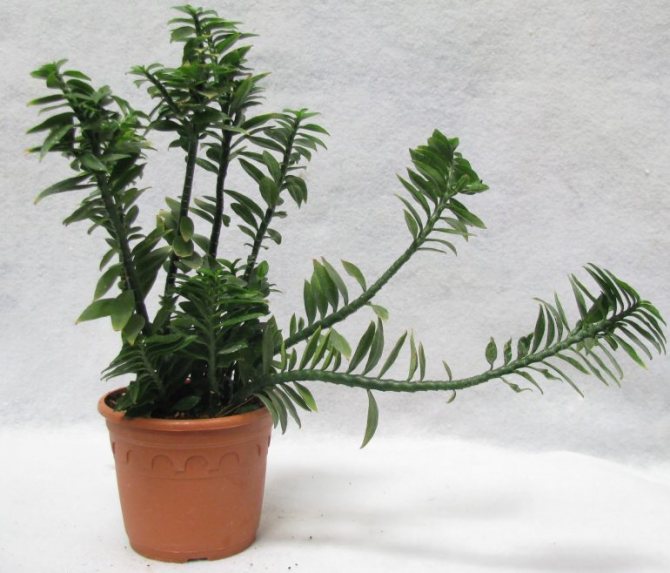

The stem is thick, the dark green leaves are beautiful, opposite. The broken shape of the shoots creates the feeling of an artificial plant. Demanding on moisture and looseness of the soil.
Pedilanthus Fink (Finkii)


Fleshy stems in a zigzag shape. The leaves are smooth, shiny, bright green, without a border. Most of the leaves are located in the upper part, the bottom is bare, requires pruning.
Pedilanthus spur (Calcaratus)


A woody type of evergreen shrub. In nature, the height of the stems is up to several meters. The shoot is spiral, covered with bright green foliage with a wavy edge. Demanding to watering and spraying.


Pedilanthus (shoe flower) is an ornamental shrub with an ornate stem and light green leaves interspersed. Many growers, having seen a bizarre plant, are interested in whether it is possible to keep a pedilanthus at home by signs.
Description
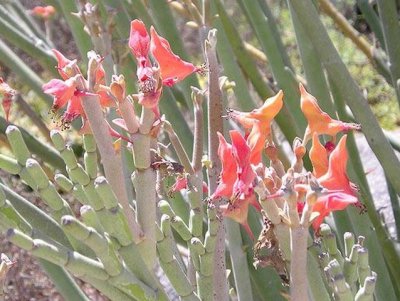

Pedilanthus represents ornamental flowering shrubbelonging to the family Euphorbiaceae.
Its name comes from Greece from the words "pedilon" and the flower "anthos".
Leaves are light green (dark or light), wavy. They can be sessile or short-petiolate, alternate, up to 8-10 cm long, smooth or slightly pubescent.
The stem is cylindrical, grayish or green in color.
The flowers are formed in dense apical inflorescences with two red, small, pointed bracts, about 2 cm in diameter. Inflorescences are pink or red. They resemble the heads of small birds or shoes.
What does the flower symbolize
Pedilanthus, due to its appearance, resembles an artificial plant. The homeland of the bush is America. In another way, the plant is called Jacob's ladder.
Pedilanthus has several varieties. The most popular type that is suitable for growing at home is called titimaloid.
Florists appreciate the bush for its properties and inherent signs. The plant has a flowering period which is also unusual. The inflorescences are similar to women's shoes, differing in different colors: from bright pink to dark red.
The appearance of the pedilanthus contributed to the popularization of the bush and the appearance of both favorable and negative signs.
Types of pedilanthus for home
In nature, there are 15 plant species and only 4 of them are suitable for indoor cultivation:
| View | Description |
| Titimaloid | Shrub, has a thick and smooth stem. Variegated green foliage with white edging around the edges. Closer to winter forms small inflorescences, has bracts of red or pink color. |
| Large-fruited | A leafless type of succulent, the stem is round, has a gray-green tint. In the fall, red umbrella-shaped flowers appear. Bracts are bright red. |
| Finca | A tree-like plant with fleshy and stepped shoots. The foliage is bright green and smooth. |
| Koalkomanensky | A miniature tree that is resistant to dry weather. The foliage is variegated. The flowers are large, have a light pink or peach color. |
The magical properties of the plant
Pedilanthus brings not only aesthetic pleasure. There are several main useful properties of the bush:
- purification and disinfection of air;
- impact on the atmosphere as an antiseptic due to the content of essential oils;
- decrease in the concentration of toxins.
In addition to negative magical properties, pedilanthus is distinguished by its toxicity. When the juice penetrates into the wound area, itching and swelling occurs. Vomiting and nausea appear if the leaf is swallowed. That is why the bush is not recommended to be placed in children's rooms. Jacob's Ladder is also a hazard to pets.
The magical property is to attract happiness and good luck. The sign is valid when you receive a bush as a gift. Some esotericists believe that Jacob's ladder is muzhegon. In this connection, the flower is not recommended to be grown by married representatives or girls of marriageable age.
Beneficial features
The benefits and harms of pedilanthus:
- Pedilanthus titimatoid often used in medicine for the manufacture of antimicrobial agents. Residents of South America use it as a psychotropic drug.
- All parts of the plant are poisonous... When handling it, you need to be careful, use gloves.
The juice is toxic and causes inflammation if it comes into contact with the skin of the hands or eyes... Keep the flower away from children and pets.
If you find an error, please select a piece of text and press Ctrl + Enter.
Is it possible to keep pedilanthus at home
Florists are attracted by the appearance of the plant. However, the omens and superstitions are rather contradictory. In some cultures, the bush is called the devil's backbone.
The beneficial properties of the plant have been proven. Jacob's Ladder has a positive effect on the microclimate of the room. The decorative qualities of the bush allow it to fit into any interior.
Esotericists emphasize that only one unfavorable superstition is known. There is a sign that it is undesirable to grow a bush for married women. Pedilanthus is considered a muzhegon flower.
Description of pedilanthus and place in the botanical classification
Pedilanthus, whose genus is 15 different in appearance plants, belong to the Euphorbia family. The appearance is so diverse that there are succulent, bushy, herbaceous forms. A common feature of all Euphorbiaceae is the whitish liquid that flows inside the stem.
In the wild, the plant is distributed throughout the American continent in a dry tropical climate, where rain is rare. May be found on the coast of the Atlantic Ocean, the coastal forests of the Amazon. On the windowsill, the tatimaloid pedilanthus was able to acclimatize to a non-tropical environment. The name of which comes from a combination of two original Greek words "pedilon" (shoe) and "anthos" (flower). The literal translation is a flower in the form of a shoe, which accurately describes the shape of inflorescences created by nature in the form of graceful boats.
The flower belongs to succulents, which means it is able to accumulate life-giving moisture in the green mass of the plant: leaves, stem. They are covered with a thick skin, and inside is a nutritious liquid that will provide life to the plant during the absence of water.
For its external characteristics, pedilanthus was given a place among elite indoor plants. Its heterogeneous leaf plates, smooth shiny stem, abundant intricate flowering made the bush desirable among flower growers and interior designers.
"Popular" name of the flower
Pedilanthus indoor plant photo Pedilanthus tithymaloides How pedilanthus blooms photo
The indigenous population of America gave the flower two opposite names. The popular name "Jacob's Ladder" was first announced to the general public during the exploration of the American continent. This is the name of the plant for its zigzag-like stems, similar to an ascending staircase. Numerous inflorescences in the form of angelic shoes gave the name a credibility.
After some time, European travelers, according to observations of the aboriginal population, in their notes wrote down the new name of the plant - "Devil's Ridge". So the flower was named for the same curved stem shape, but the characteristics of a burning, poisonous white juice were added. Milk suspension is dangerous for children, so the flower is not grown in childcare facilities and rooms.
The shape of numerous inflorescences also gave it the name - "Fairy Slippers", fancy pink boats are strewn with the bush. Outwardly, the flower looks like the stairs of a palace, from where princesses or fairies descended, having lost their shoes.
If the flower has a bright color of green mass, then the inflorescences are not so remarkable. Pedilanthus shoes lack color saturation, but not the charm that a flower possesses.
Signs and superstitions about Pedilanthus titimaloid
Pedilanthus is an unpretentious plant. A change in his state can speak of positive and unfavorable changes in life:
- The wilting of a flower is considered a bad omen. If a bush sheds leaves, one of the household members will get sick.
- The lack of flowering is a sign of a violation of the harmony of family relations. A flower cannot grow well amid frequent quarrels and disagreements.
- The downward slope of the leaves is considered a sign indicating a professional decline.
- The elongation of the stem and its exposure in the presence of light leaves is a sign of an imminent separation from a loved one.
- Dry tips of the leaves indicate an impending disease, for example, ARVI.
A bad omen is the rotting of the pedilanthus. According to popular superstition, the death of a plant portends an accident. The flower warns the owner of a possible danger.
Signs on the state of the flower
Pedilanthus belongs to unpretentious home flowers - a fairly well-lit place and regular watering. However, there are frequent cases of "disease" of the plant. And on this score there are signs and superstitions - it must be remembered that the flower will not wither just like that, which means that something is wrong in the family.
So what does a diseased plant signal about?
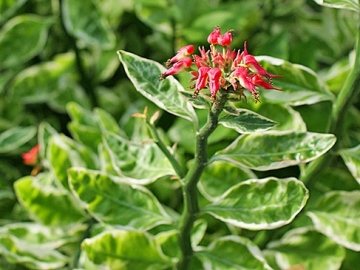

- If the pedilanthus suddenly began to shed leaves, it means that one of the household members is sick or will soon fall ill.
- The plant does not bloom. Such a sign means that the harmony of family relations is disturbed in the house: quarrels, swearing and abuse are too often heard.A delicate plant simply will not "release" its flowers into such an atmosphere.
- The leaves bent down. Such a sign means possible problems in the professional sphere, or a person needs a creative upsurge.
- The stem became long and bare, and the leaves suddenly brightened. Perhaps parting with a loved one or someone from the household will leave home.
- The leaves have changed their color. To changes in life: if the leaf plates have become darker - to trouble, if lighter - to new pleasant impressions.
- The tips of the leaves dry out. It is necessary to closely monitor your health: colds or other not serious, but very unpleasant, diseases are possible.
- If the plant begins to rot, this is an unkind sign. An accident can happen to someone close to you, so you need to take precautions. Pedilanthus warns of danger, protects and becomes a talisman for its owners.
Where is the best place to put the plant
According to the signs, the pedilanthus can be placed in the workplace. Superstition says that such a localization of the magic flower contributes to a promotion or increase in wages.
If you take a stalk on the street, in a public place, and plant it at home, you can count on getting a prestigious or high-paying job.
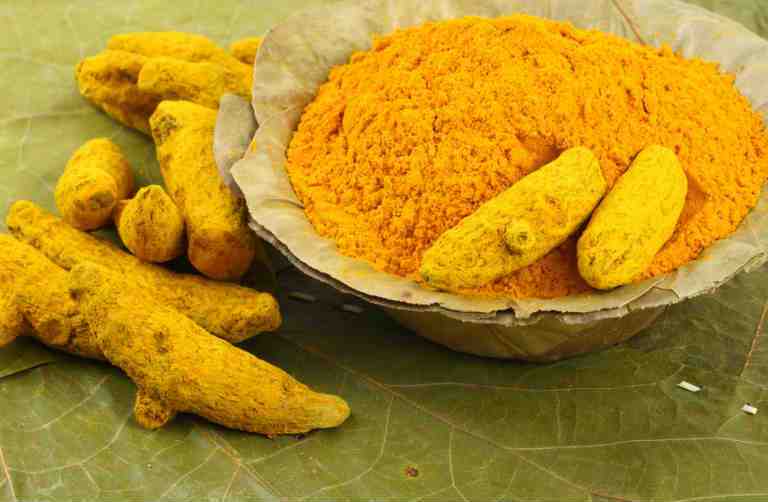

A prerequisite for content is an abundance of light. The flower should be protected from direct sunlight. It is advisable to place the pedilanthus on the windowsill of the east or west side. It is this arrangement of the pot, according to the signs, that brings the maximum benefit. In summer, the bush can be planted in the garden and in the flower bed.
Difficult pedilanthus: signs for the home
The popularity of growing on the windowsill, its intricate look with dancing stems made the flower a symbol of many events.
- The flower received as a gift will bring changes to the interior of the house - perhaps it will be a renovation or a change of furniture.
- Self-purchase of a plant, for example, a cuttings brought from a public place, will become a symbol of professional growth, a change of workplace with attractive conditions.
- Accommodation in the office will bring pleasant professional chores that will end in success and advancement on the career ladder.
- It is better not to put at home in a nursery or bedroom.
- According to some beliefs, variegated flowers are expelled from the house of men.
When purchasing a new inhabitant for your home greenhouse - pedilanthus, you need to remember about its tropical origin. It perfectly coexists with other succulents, adapts well under the crown of tall flowers. On the southern sides, it can grow on shelves where there is enough light, but without bright scorching rays.
How to avoid the consequences predicted in the signs
To avoid the implementation of unfavorable signs, pedilanthus must be carefully looked after:
- keep in a comfortable temperature of about 25 ° C in summer and 15 ° C in winter;
- provide adequate lighting and absence of direct sunlight;
- water exclusively with settled water (room temperature);
- choose soil for both succulents and cacti.
Adequate care of Jacob's ladder will avoid plant death and bad omens.
Bloom
The plant pleases its owners with wonderful flowering in spring. But for this, certain wintering conditions must be met:
- The air temperature in the room is not higher than 18 degrees;
- Adequate watering (in winter, it can be reduced to once a month, provided the air is humid);
- Fertilizers must not be used during dormant periods (in winter).
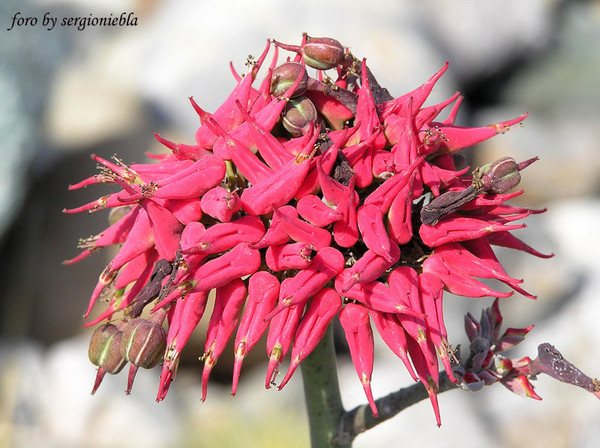

If the plant is well "rested", then bright flowering in the spring season is guaranteed.
What you need to know before buying a pedilanthus
Pedilanthus is a luxurious shrub with randomly scattered shoots and miniature leathery leaves.Their color changes and each subspecies has its own, and can be either fresh olive, bright light green, or gradually turn into gray undertones. This exotic comes from the tropical forests of southern, northern and central America. Belongs to the family of succulents, well adapted to the environment and undemanding to the conditions of care.
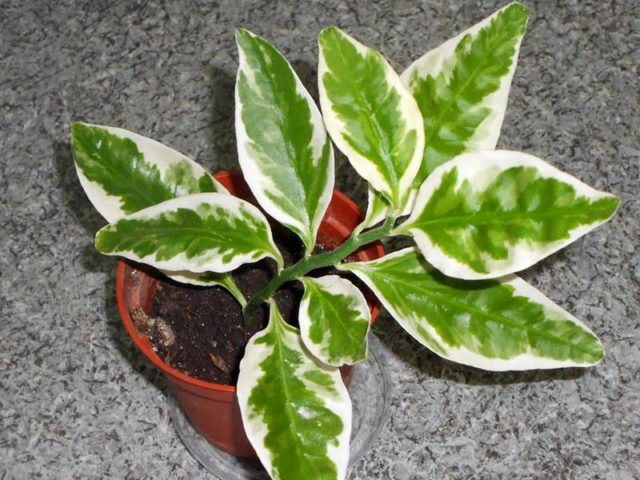

Even with rare watering, he will survive due to his own natural thrift. Its dense shoots will retain the right amount of moisture, creating an excellent basis for nutrition during dry periods. Under unfavorable conditions of care, the plant completely gets rid of the "green cap". Their function is taken over by a thick, fleshy, "dancing" stem. The presence of white thick juice in it allowed the flower to be ranked among the milkweed family.
Photo pedilanthus
Who can give a flower
It is believed that if you donate a pedilanthus, you can expect positive changes. Thus, the bush can be considered a good gift. The plant is often presented for housewarming.
It is considered a good omen to receive a pedilanthus as a gift. Soon, happiness and wealth await the new owner. If someone breaks off a stalk for the purpose of subsequent reproduction of the plant, the owner will change his place of work or occupation.
Attention! You can redip a flower if you have a marriageable daughter. This is due to the superstition that the bush is muzhegon.
How pedilanthus blooms
Most species of milkweed bloom 1-2 years after transplanting. The buds are formed from July to October, depending on the conditions of care. For the flowering of pedilanthus, a constant temperature is needed without drops and drafts. Daylight hours are at least 12 hours, in cloudy weather it is better to turn on additional light, so you can stimulate the fastest formation of inflorescences.
The titmaloid species has a special property: before flowering, the leaf color changes closer to pink. During this period, watering is performed in small quantities strictly according to the schedule, waterlogging or drying out of the soil can lead to a violation of vegetative processes.
In the photo, the flowering of pedilanthus:
Pedilanthus diseases and home growing problems
Improper watering is manifested by the lack of flowering. Due to the lack of moisture, the plant does not have enough strength to set color, and the excess can provoke rotting of the root system and leaf discharge.
After regular fertilization, you may notice that the leaves are falling off, but not all growers know what to do with this. The reason is often nitrogenous substances in the top dressing, the excess of which causes root decay and can lead to the death of the plant.
Lack of light is manifested by significant stretching of shoots... Because of this, the pedilanthus loses its attractiveness, the leaves turn pale.
Blackness on stems and leaf plates is a signal of excessive watering or soil compaction. It is required to immediately remove the damaged parts and transplant the plant into a suitable substrate.


Humidity
This flower is unpretentious to moisture. It tolerates the dry climate of a heated room well. However, leafy species need to be systematically sprayed with a spray bottle, especially in winter.
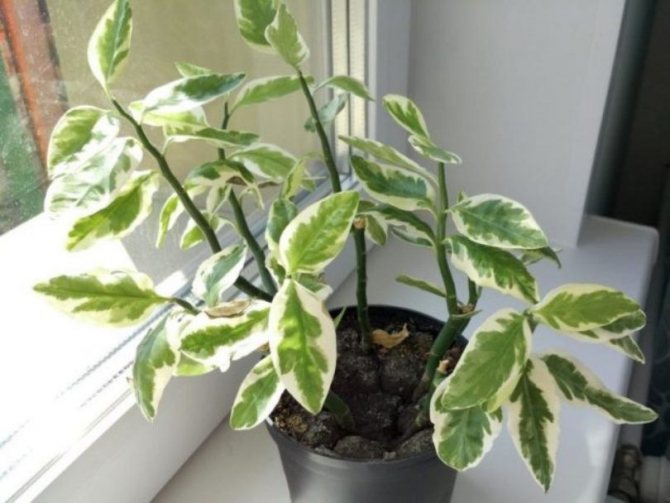

Spraying is strictly prohibited after decorative pruning or cuttings, as in this case it can contribute to the formation of rot.
1. Seven Secrets of Success:
| 1. Growing temperature: rather warm content in the spring - summer period - the plants are kept at a temperature of 22 - 24 ° C. In the winter months, a cool dormant period should be provided at a temperature of about 16 ° C. |
| 2. Lighting: Well-lit areas with a lot of reflected sunlight. Direct sunlight can hit the plants in the morning and in the evening, for 2 - 3 hours daily. |
| 3. Watering and humidity: The frequency of watering will depend not only on the ambient temperature, but also on the number and size of leaves - in varieties with a large number of leaf plates, moisture evaporates faster and you need to water them more often. The air humidity does not need to be increased. |
| 4. Pruning: to maintain a compact shape, the long stems of the pedilanthus can be cut at the desired height, the shoots of small bushes should be pinched from time to time. |
| 5. Priming: well-drained soils with a lot of nutrients. Adapts well to most soil types. |
| 6. Top dressing: during the period of active growth, every 2 weeks with liquid fertilizers for succulent plants, in the fall, feeding is gradually reduced to naught and in the winter months the plants are not fed. |
| 7. Reproduction: apical and stem cuttings rooted in spring and summer, sowing seeds in spring. |
Botanical name: Pedilanthus.
Pedilanthus flower - family... Euphorbiaceae.
Origin... Central America, Mexico.
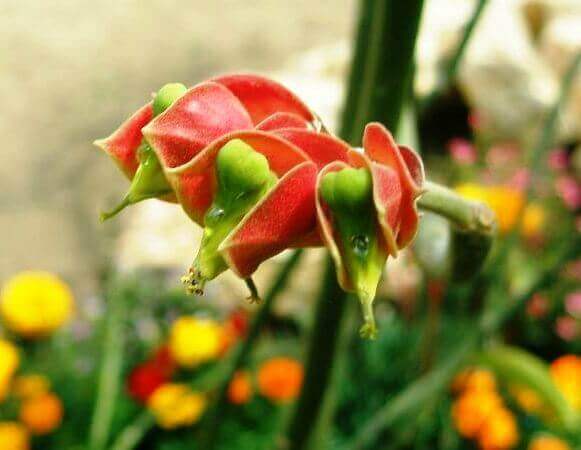

Description... The Pedilanthus genus consists of about 15 species of multi-stem shrubs or trees. The stems are erect, rarely branching, but they grow in zigzags - making turns at the locations of leaf nodes. Leaves are sessile, 4 to 8 cm long, opposite, rather dense, oval or lanceolate. The color of the leaves is quite varied - from standard green to green with white, yellow or pink spots and stripes in variegated species. The surface of the leaves has a smooth, waxy coating. The stems and leaves are very succulent and fleshy, helping plants to store moisture in case of dry weather.
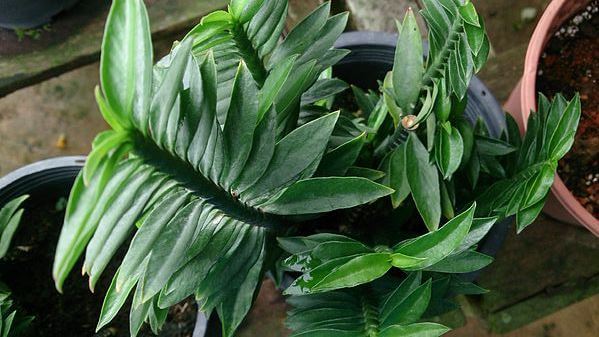

During the summer months, the plant blooms with small flowers, collected in small inflorescences at the tops of the stems. The flowers are not as interesting as the large, bright bracts in shades of red or pink. The appearance of the plant can be different and it will depend on the environmental conditions. Since pedilanthus grows in different climatic zones, in dry areas, in order to save moisture and store its reserves, the plants got rid of the leaves, but acquired thick branches, and with a sufficient amount of moisture, the bushes already become the owners of lush green foliage.
↑ Up,
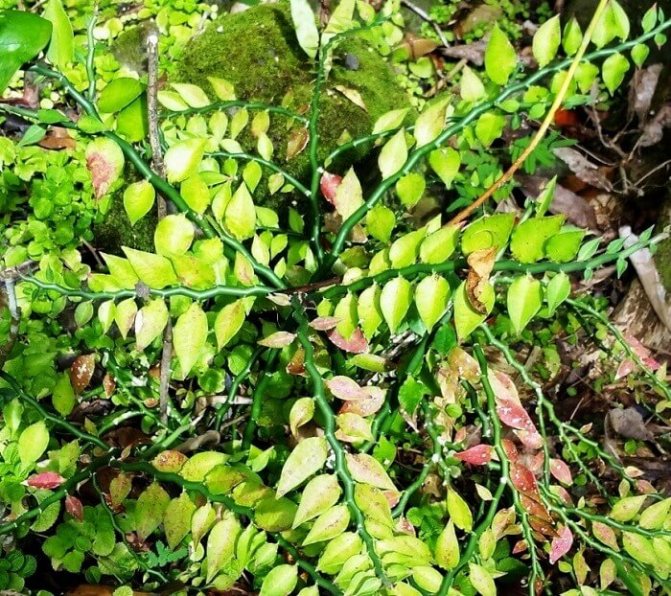

Height... Indoor plant reaches 80 - 150 cm, grows rather slowly. In nature, there are shrubs, the growth of which can reach 3 m. Plants develop rather slowly and within a year they can add 10-15 cm of growth.
↑ Up,
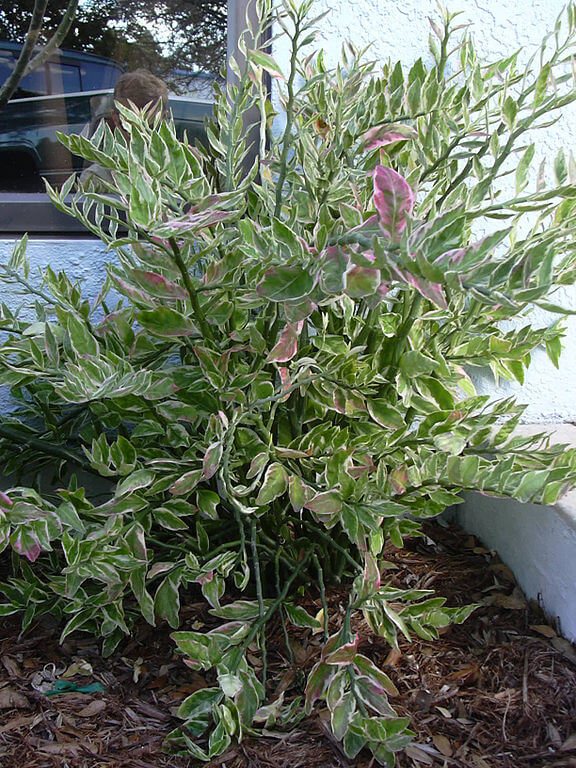

Diseases
Indoor pedilanthus is susceptible to fungal diseases that affect the roots and stems, gray or root rot, but they are caused by improper watering and feeding. If the rot damages the shoots, then they should be cut 1 cm below the affected part. If root rot is found, the damaged roots are cut. But it so happens that the whole root is affected, in which case it is better to cut the plant into cuttings and germinate. The following pests are of great danger:
- spider mite;
- shield;
- aphid;
- whitefly;
- sciarids (flower midge);
- mealybug.
Aphids, scale insects, spider mites can be removed mechanically by removing the leaves with gloved hands, then spray with a solution of laundry soap and lemon juice, rinse in an hour under the shower.
Whitefly, sciarides and mealybugs are more difficult to remove, for this they use spraying with salicylic acid or special means: Aktara, Forse, Fitoverm, Green soap, Actellik, watering and spraying method or a complete change of soil to a new steamed one.
Variety of species
Consider what types of pedilanthus are. In the shape and color of the leaves, there are species with white edges that outwardly resemble Benjamin's ficus. True, he is from a different family - mulberry.


Their scientific classification is similar: both are from the eakuryote domain, from the same kingdom, division and class, and diverge in species.But both look beautiful in a room interior, and the demand for them is huge. "American" is gradually gaining high places in the flower rating.
He has a few more nicknames. According to the leaves, this is Jacob's ladder, and because of their variegated form - the devil's ridge.
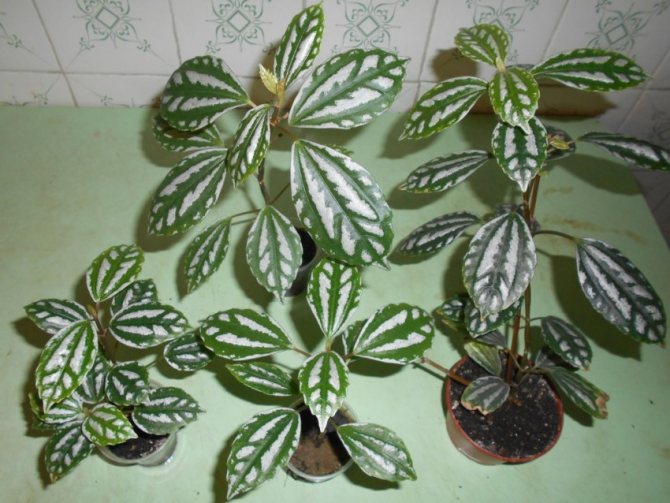

The pedilanthus has 15 shoes and 15 flowers - according to the number of species: Fink pedilanthus, clawed, koalkomanensky and further, which have no synonyms with scientific names.
General description with photo
Pedilanthus is one of the many representatives of the Euphorbia family and is a profusely branched shrub or takes on a tree-like shape. Representatives of the genus can vary greatly depending on the growing conditions. The maximum height is 3 m for tree forms. Shoots of cylindrical section and zigzag shape can be divided into segments. Their color varies from light olive and grayish to dark green. The shape of the leaf plate is often oval, pointed towards the end, can be pubescent or glossy, smooth. The coloring is variegated, of different color combinations (more often with pink) in variegated species. The average length of the leaves is 10 cm. The plant has a pronounced dormant period, during which it can shed up to 50% of its foliage.
How to propagate
Pedilanthus propagates by cuttings and seeds, some species by dividing bushes. But, those that are adapted for growing in apartments are bred in two ways.
By cuttings
Reproduction of pedilanthus by cuttings is carried out in the spring (March-April) or in the summer (June-July), in winter it goes into hibernation, so most of the cuttings die. The apical shoots of 10-12 cm are cut from the bushes, it is better to perform this procedure during formative pruning.
Be sure to wear gloves, milky juice irritates the skin and mucous membranes, can cause nausea and vomiting.
The cuttings are washed from the juice under running water, laid out on paper for drying. The bottom 2-4 leaves are cut and buried in a third part into a moistened (almost dry) substrate (a mixture of sand and peat, in a ratio of 2: 1) or placed in a glass with warm softened water. Root formation takes place within 3-5 weeks. You can transplant it into a pot after 3-4 weeks, when the root mass is increased.
Seeds
Reproduction by seeds is a rather complicated process, their germination is weak. The sprouts are often sick, very fragile. Seeds collected from their bush sometimes germinate better than store seeds, provided that the quality of the planting material is high, the pack is not opened or damaged, the shelf life is valid.
Succulent substrate or sand is suitable for germination, they are slightly moistened. Seeds are poured evenly over the entire surface of the soil, sprinkled on top with a layer of 0.5 to 1 cm and covered with a transparent lid, oilcloth or glass.
Seedlings appear in 7-15 days, if the conditions are met, they will sprout together. The temperature is from +25 to + 27 ° C, the place is bright, but not in direct sunlight with partial shade.
Pedilanthuses are often affected by fungal diseases, so the greenhouse is opened daily for ventilation in order to exclude the appearance of mold fungi.
When sprouts appear, the greenhouse is opened completely, placed in a lighter place, but the bright sun is excluded. You can transplant such a plant by transferring it into separate pots when 2 real leaves appear.
Flower care
Pedilanthus blooms magnificently in spring, but to see the abundance of bright "shoes", you need to provide the plant with proper care.
Temperature... A comfortable temperature is +25 degrees. In winter, you need to keep the flower at a temperature of + 15-17 degrees.
Lighting... A dim but stable light is necessary for the normal life of the pedilanthus. In summer, it can be taken outside in the shade or on a shaded balcony.
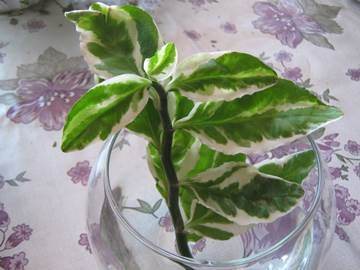

Watering... Only with settled water at room temperature. In the summer, you need to water the pedilanthus every other day, and in the winter, just once or twice a week is enough.
Land... The soil for the plant is the same as for cacti and succulents - with a mixture of coarse sand and earth.
Fertilizer... It is better to feed the plant from the beginning of autumn to the end of spring - a couple of times a week. Fertilizers can be purchased at the store.
Pot... In a too large vessel, the flower will be uncomfortable, therefore, it is better to plant the pedilanthus in a narrow, low pot.
An unusual native of American tropical forests, pedilanthus easily took root in our country. Therefore, if you want to decorate your home with an unusual plant, pedilanthus is an excellent choice. In addition, the health value of such a pet “pet” can hardly be overestimated. And its fleshy leaves, as if cast from wax, and bright flowers, will delight and charm the owners of the house all year round, portending only good changes in the future. Is this not a reason to acquire such exotic things on the window?


Pedilanthus belongs to the euphorbia genus and belongs to tropical plants, therefore, it loves very stable lighting, even if not the brightest. There are more than ten species of this plant, but not all are grown in apartments. You should carefully study the features of the plant, as well as the signs and superstitions associated with it.
Outer aura
Follow the instructions for care and watering of the pedilanthus. The optimum air temperature is about 25 Celsius. For rest in the off-season - 14 - 18. Its enemies are radiators or air heaters. As a punishment for the owners, he can throw off the leaves.
The main problems of the flower and how to fix them
Despite the unpretentiousness, sometimes specific problems may arise:
- falling foliage caused by a lack of sun rays and improper irrigation;
- if the greens begin to dry and turn yellow, then this indicates a lack of moisture in the air - to eliminate the problem, it is enough to simply irrigate with filtered water;
- if it is not possible to make it bloom, then most likely it simply does not have enough warmth and light.
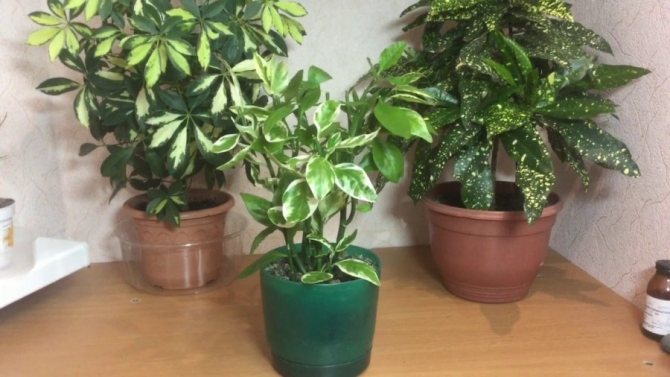

Priming
The soil for this succulent should be loose and light, and also allow moisture and air to pass through well. You can buy a ready-made mixture for cacti or make it yourself by mixing turf, leafy soil and river sand in equal parts. It is appropriate to add a small amount of vermiculite.
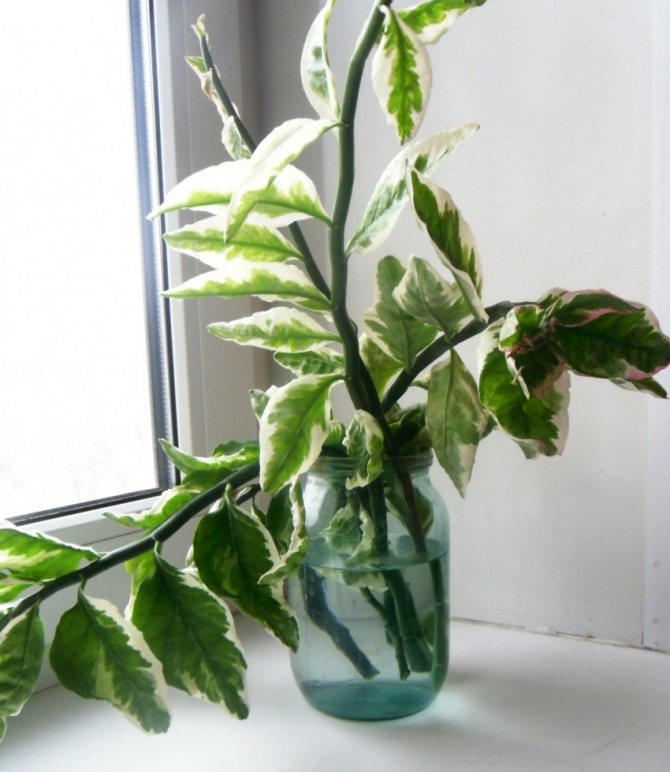

In conclusion, we note that pedilanthus for the home is an excellent choice, since this plant is not only highly decorative, but also a leader in the production of oxygen.
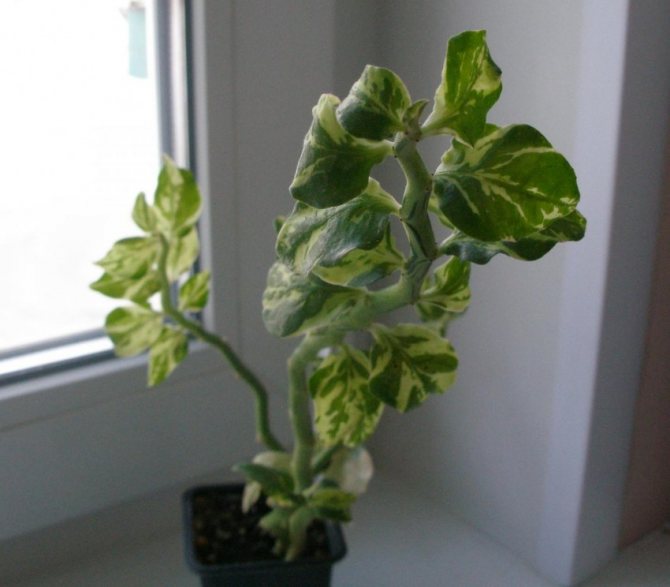

Care errors and their elimination
Common mistakes in pedilanthus care and how to fix them:
| Problem | The reasons | Decision |
| Shedding foliage | Violation of the temperature regime, improper watering | In summer, transplant the plant into new soil, do not flood it, in winter, reduce watering, do not put the flowerpot in drafts |
| Pulling shoots | Little light | Cut off shoots, rearrange the plant in a brighter place |
| Drooping stems and leaves | Lack of moisture | Water the pedilanthus regularly to keep the soil dry |
| Lack of flowering | Poor lighting, warm wintering | Choose a well-lit place for a flower, ensure a temperature of + 14-17 degrees in winter |


Where does it fit indoors?
Growing a pedilanthus in a pot is not difficult. It is clear that the "Americans" love the bright sun. Therefore, the room should also have a lot of light.
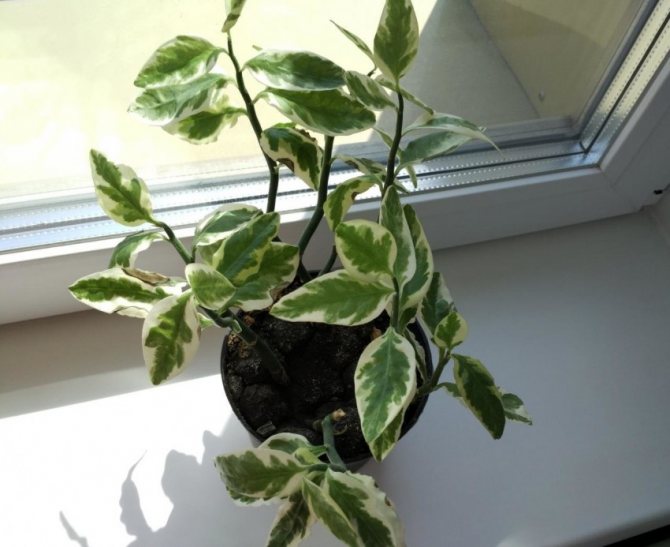

In summer, the plant simply bask in the freshness, leave a place for it closer to the open windows, and in a private area - on the ground, with some shade of trees.
Cover the pot completely from the rain. On winter evenings, several hours of electric supplementary lighting are required.
Transfer
The plant has an average size, proportional to the aboveground part of the rhizome, therefore, the need for transplanting should be guided by the volume of the crown. The width and height of the flowerpot should be approximately equal to each other. The transplant should begin in the spring, when the growth of the first young leaves will be noticed.Until the root system expands to the full width of the pot, there is no need for transplanting. The soil during the "housewarming" must be changed completely, as much as possible. After transplanting, the plant is left in a shaded place for at least a week for final adaptation.
It is necessary to work with gloves, as its juice is poisonous!
Lighting and location selection
Succulent is quite photophilous. The optimal place for him is a southern, western or eastern window sill. It should be shaded from the bright rays of the midday sun.
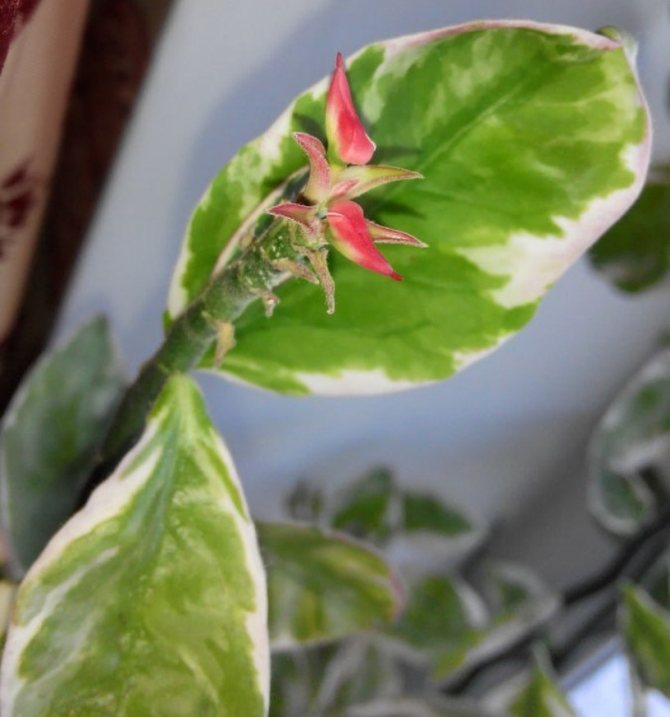

In the spring-summer season, it is better to take the plant out into the garden or on the balcony. In this case, it is imperative to provide protection from precipitation and provide diffused lighting.
Reproduction methods
When pruning for propagation, you can use apical cuttings. Seed propagation is also used, but rarely.
Seeds
It is very difficult to collect seeds at home, so it is better to buy them. They are sown in flat containers filled with a mixture of peat and sand (1: 1) to a depth of 1.5 cm. Cover the container with foil and provide a temperature of about +23 degrees. The film must be removed periodically to ventilate and moisten the soil. After seed germination, the cover can be removed. Plants dive into separate pots after the appearance of 4 true leaves.
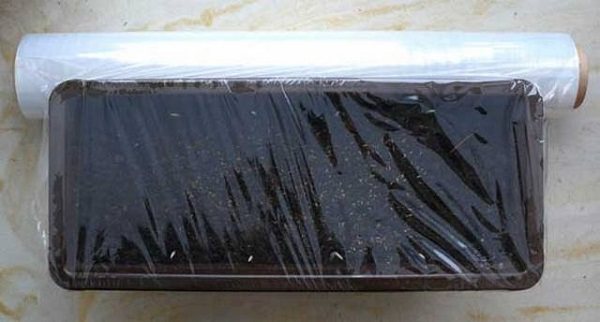

Cuttings
Cut the top shoots 8-10 cm long. Remove the leaves from the bottom. Let dry for 1-2 days. Plant in damp sand at an angle. Cover the top with a plastic bottle or jar. Root cuttings at a temperature of + 22-25 degrees. Periodically remove the shelter so that the cuttings are ventilated. After the appearance of young leaves, the rooting process can be considered complete. Cuttings can be planted in separate pots in the growing medium.




